

How To Write an Autobiography 2024 (Tips, Templates, & Guide)
Your life story has value, merit, and significance. You want to share it with the world, but maybe you don’t know how .
Here’s how to write an autobiography:
Write an autobiography by creating a list of the most important moments, people, and places in your life. Gather photos, videos, letters, and notes about these experiences. Then, use an outline, templates, sentence starters, and questions to help you write your autobiography .
In this article, you are going to learn the fastest method for writing your autobiography.
We are going to cover everything you need to know with examples and a free, downloadable, done-for-you template.
What Is an Autobiography?

Table of Contents
Before you can write an autobiography, you must first know the definition.
An autobiography is the story of your life, written by you. It covers the full span of your life (at least, up until now), hitting on the most significant moments, people and events.
When you write your autobiography, you write an intimate account of your life.
What Should I Include In an Autobiography?
If you are scratching your head, baffled about what to include in your autobiography, you are not alone.
After all, a big part of how to write an autobiography is knowing what to put in and what to leave out of your life story. Do you focus on every detail?
Every person? Won’t your autobiography be too long?
A good way to think about how to write an autobiography is to use the Movie Trailer Method.
What do movie trailers include?
- High emotional moments
- The big events
- The most important characters
When you plan, organize, and write your autobiography, keep the Movie Trailer Method in mind. You can even watch a bunch of free movie trailers on YouTube for examples of how to write an autobiography using the Movie Trailer Method.
When wondering what to include in your autobiography, focus on what would make the cut for a movie trailer of your life:
- Most important people (like family, friends, mentors, coaches, etc.)
- Significant events (like your origin story, vacations, graduations, life turning points, life lessons)
- Emotional moments (When you were homeless, when you battled a life-threatening condition, or when you fell in love)
- Drama or suspense (Did you make it into Harvard? Did your first surgery go well? Did your baby survive?)
Autobiography Structure Secrets
Like any compelling story, a well-structured autobiography often follows a pattern that creates a logical flow and captures readers’ attention.
Traditionally, autobiographies begin with early memories, detailing the writer’s childhood, family background, and the events or people that shaped their formative years.
From here, the narrative typically progresses chronologically, covering major life events like schooling, friendships, challenges, achievements, career milestones, and personal relationships.
It’s essential to weave these events with introspective insights.
This allows readers to understand not just the what, but also the why behind the author’s choices and experiences.
Towards the end, an effective autobiography often includes reflections on lessons learned, changes in perspective over time, and the wisdom acquired along life’s journey.
Example of the Structure:
- Introduction: A gripping event or anecdote that gives readers a hint of what to expect. It could be a pivotal moment or challenge that defines the essence of the story.
- Childhood and Early Memories: Recounting family dynamics, birthplace, cultural background, and memorable incidents from early years.
- Adolescence and Discovering Identity: Experiences during teenage years, challenges faced, friendships formed, and personal evolutions.
- Pursuits and Passions: Describing education, early career choices, or any particular hobby or skill that played a significant role in the author’s life.
- Major Life Events and Challenges: Chronicles of marriage, parenthood, career shifts, or any significant setbacks and how they were overcome.
- Achievements and Milestones: Celebrating major accomplishments and recounting the journey to achieving them.
- Reflections and Wisdom: Sharing life lessons, changes in beliefs or values over time, and offering insights gained from lived experiences.
- Conclusion: Summarizing the journey, contemplating on the present state, and sharing hopes or aspirations for the future.
How To Write an Autobiography Quickly: Strategies & Templates
Want the quickest way to organize and write your autobiography in record time? You can literally write your autobiography in 7 days or less with this method.
The secret is to use done-for-you templates.
I have personally designed and collected a series of templates to take you from a blank page to a fully complete Autobiography. I call this the How to Write an Autobiography Blueprint.
And it’s completely free to download right from this article. 🙂
In the How to Write an Autobiography Blueprint, you get:
- The Autobiography Questions Template
- The Autobiography Brainstorm Templates
- The Autobiography Outline Template
Here is an image of it so that you know exactly what you get when you download it:

How To Write an Autobiography: Step-by-Step
When you sit down to write an autobiography, it’s helpful to have a step-by-step blueprint to follow.
You already have the done-for-you templates that you can use to organize and write an autobiography faster than ever before. Now here’s a complete step-by-step guide on how to maximize your template.
- Brainstorm Ideas
- Order your sections (from medium to high interest)
- Order the ideas in each section (from medium to high interest)
- Write three questions to answer in each section
- Choose a starter sentence
- Complete a title template
- Write each section of your by completing the starter sentence and answering all three questions
Brainstorm Your Autobiography
The first step in writing your autobiography is to brainstorm.
Give yourself time and space to write down the most significant people, events, lessons, and experiences in your life. The templates in the How to Write an Autobiography Blueprint provide sections for you to write down your brainstormed ideas.

This will help you organize your ideas into what will become the major sections of your book.
These will be:
- Y our most significant events and experiences.
- The people who impacted you the most.
- The challenges you have overcome.
- Your achievements and successes.
- The lessons you have learned.
The “other” sections on the second page of the Brainstorm template is for creating your own sections or to give you more space for the sections I provided in case you run out of space.
As I brainstorm, I find asking myself specific questions really activates my imagination.
So I have compiled a list of compelling questions to help you get ideas down on paper or on your screen.

Order Your Sections (From Medium to High Interest)
The next step is to order your main sections.
The main sections are the five (or more) sections from your Brainstorm templates (Significant events, significant people, life lessons, challenges, successes, other, etc). This order will become the outline and chapters for your book.
How do you decide what comes first, second or third?
I recommend placing the sections in order of interest. Ask yourself, “What’s the most fascinating part of my life?”
If it’s a person, then write the name of that section (Significant People) on the last line in the How to Write an Autobiography Outline Template. If it’s an experience, place the name of that section (Significant Events) on the last line.
For example, if you met the Pope, you might want to end with that nugget from your life. If you spent three weeks lost at sea and survived on a desert island by spearfishing, that is your ending point.
Then complete the Outline by placing the remaining sections in order of interest. You can work your way backward from high interest to medium interest.
If you are wondering why I say “medium to high interest” instead of “low to high interest” it is because there should be no “low interest” parts of your autobiography.
But wait, what if you met the Pope AND spent three weeks lost at sea? How do you choose which one comes first or last?
First of all, I want to read this book! Second, when in doubt, default to chronological order. Whatever event happened first, start there.
Here is an example of how it might look:

Order The Ideas in Each Section (From Medium To High Interest)
Now, organize the ideas inside of each section. Again, order the ideas from medium to high interest).
Within your “Significant People” section, decide who you want to talk about first, second, third, etc. You can organize by chronological order (who you met first) but I recommend building to the most interesting or most significant person.
This creates a more compelling read.
Keep in mind that the most significant person might not be the most well-known, most famous, or most popular. The most significant person might be your family member, friend, partner, or child.
It comes down to who shaped your life the most.
So, if your “significant people list” includes your dad, a famous social media influencer, and Mike Tyson, your dad might come last because he had the biggest significance in your life.
Write Three Questions to Answer in Each Section
Ok, you’ve done the heavy lifting already. You have the major sections organized and outlined.
Next on your autobiography to-do list is to choose and write down three questions you are going to answer in each section. You can write your questions down in the provided “boxes” for each section on the template outline (or on another piece of paper.
This is easier than it might seem.
Simply choose one of the sample autobiography questions below or create your own:
- Why did I choose this person/event?
- What does this person/event mean to me?
- How did I meet this person?
- Where did it happen?
- When did it happen?
- Why did it happen?
- How did it happen?
- What is the most interesting part?
- How did I feel about this person or event?
- How do I feel now?
- Why does this person or event matters to me?
- How did this person or event change my life?
- What is the most challenging part?
- How did I fail?
- How did I succeed?
- What did I learn?
Questions are the perfect way to write quickly and clearly. I LOVE writing to questions. It’s how I write these blog posts and articles.
Choose a Starter Sentence
Sometimes the hardest part of any project is knowing how to start.
Even though we know we can always go back and edit our beginnings, so many of us become paralyzed with indecision at the starting gate.
That’s why I provided sample starter sentences in your How to Write an Autobiography Blueprint.
Here are the story starters:
- I began writing this book when…
- Of all the experiences in my life, this one was the most…
- I’ve been a…
- My name is…
- Growing up in…
- It wasn’t even a…
- It all started when…
- I first…
- I was born…
Keep in mind that you do not need to begin your book with one of these story starters. I provide them simply to get you going.
The key is to not get bogged down in this, or any, part of writing your autobiography. Get organized and then get writing.
Complete a Title Template
At the top of the How to Write an Autobiography Outline is a place for you to write your book title.
Some authors struggle forever with a title. And that’s ok. What’s not ok is getting stuck. What’s not ok is if coming up with your title prevents you from finishing your book.
So, I provided a few title templates to help juice your creativity.
Just like the story starters, you do not need to use these title templates, but you certainly can. All you need to do is fill in the title templates below and then write your favorite one (for now) at the top of your outline. Presto! You have your working title.
You can always go back and change it later.
How to Write an Autobiography Title templates:
- [Your Name]: [Phrase or Tag Line]
- The [Your Last Name] Files
- Born [Activity]: A [Career]’s Life
- The Perfect [Noun]: The Remarkable Life of [Your Name]
Examples using the Templates:
- Christopher Kokoski: Blog Until You Drop
- The Kokoski Files
- Born Writing: A Blogger’s Life
- The Perfect Freelancer: The Remarkable Life of Christopher Kokoski
Write Your Autobiography
You have your outline. You have your title, templates, and sentence starters. All that is left to do is write your autobiography.
However, you can use tools like Jasper AI and a few other cool tricks to craft the most riveting book possible.
This is the easy way to remarkable writing.
Check out this short video that goes over the basics of how to write an autobiography:
How To Write an Autobiography (All the Best Tips)
Now that you are poised and ready to dash out your first draft, keep the following pro tips in mind:
- Be vulnerable. The best autobiographies share flaws, faults, foibles, and faux pas. Let readers in on the real you.
- Skip the boring parts. There is no need to detail every meal, car ride, or a gripping trip to the grocery store. Unless you ran into the Russian Mafia near the vegetables or the grocery store is perched on the side of a mountain above the jungles of Brazil.
- Keep your autobiography character-driven . This is the story of YOU!
- Be kind to others (or don’t). When writing about others in your story, keep in mind that there may be fallout or backlash from your book.
- Consider a theme: Many autobiographies are organized by theme. A perfect example is Becoming . Each section of the book includes “becoming” in the title. Themes connect and elevate each part of the autobiography.
- Write your story in vignettes (or scenes). Each vignette is a mini-story with a beginning, middle, and end. Each vignette builds. Each vignette should be described in rich sensory language that shows the reader the experience instead of telling the reader about the experience. Each vignette is immersive, immediate, and intimate.
- Include snippets of dialogue. Use quotation marks just like in fiction. Show the dialogue in brief back-and-forth tennis matches of conversation. Remember to leave the boring parts out!
- Choose a consistent tone. Some autobiographies are funny like Bossy Pants by Tina Fey. Others are serious such as Open by Andre Agassi. Your story (like most stories) will likely include a mix of emotions but choose an overall tone and stick with it.
- Don’t chronicle, captivate . Always think about how to make each section, each chapter, each page, each paragraph, and each sentence more compelling. You want to tell the truth, but HOW you tell the truth is up to you. Create suspense, conflict, and mystery. Let drama linger until it becomes uncomfortable. Don’t solve problems quickly or take away tension right away.
How Do I Format an Autobiography?
Most autobiographies are written in the first person (using the pronouns I, me, we, and us).
Your autobiography is written about you so write as yourself instead of pretending to be writing about someone else.
Most autobiographies are also written in chronological order, from birth right up to your current age, with all the boring parts left out. That doesn’t mean you can’t play around with the timeline.
Sometimes it’s more interesting to start at a high moment, backtrack to the beginning and show how you got to that high moment.
Whatever format you choose, be intentional, and make the choice based on making the most compelling experience possible for your readers.
How Long Should an Autobiography Be?
There are no rules to how long an autobiography should be but a rough guideline is to aim for between 200 and 400 pages.
This will keep your book in line with what most readers expect for books in general, and will help get your book traditionally published or help with marketing your self-published book.
How To Write a Short Autobiography
You write a short autobiography the same way that you write a long autobiography.
You simply leave more out of the story.
You cut everything down to the bones. Or you choose a slice of your life as you do in a memoir. This often means limiting the people in your book, reducing the events and experiences, and shrinking your story to a few pivotal moments in your life.
How To Start an Autobiography
The truth is that you can start your autobiography in any number of ways.
Here are four common ways to begin an autobiography.
- Start at the beginning (of your life, career or relationship, etc.)
- Start at a high moment of drama or interest.
- Start at the end of the story and work backward
- Start with why you wrote the book.
Good Autobiography Titles
If you are still stuck on titling your autobiography, consider going to Amazon to browse published works. You can even just Google “autobiographies.”
When you read the titles of 10, 20, or 50 other autobiographies, you will start to see patterns or get ideas for your own titles. (HINT: the title templates in the Autobiography Blueprint were reverse-engineered from popular published books.
Also, check out the titles of the full autobiography examples below that I have included right here in this article.
Types of Autobiographies
There are several different kinds of autobiographies.
Each one requires a similar but slightly nuanced approach to write effectively. The lessons in this article will serve as a great starting point.
Autobiography Types:
- Autobiography for School
- Autobiography Novel
- Autobiography for a Job
- Short Autobiography
- Autobiography for Kids
Therefore, there is actually not just one way to write an autobiography.
Memoir vs. Autobiography: Are They The Same?
It’s common to feel confused about a memoir and an autobiography. I used to think they were the same thing.
But, nope, they’re not.
They are pretty similar, which is the reason for all the confusion. A memoir is the story of one part of your life. An autobiography is the story of your full life (up until now).
What Is the Difference Between an Autobiography and a Biography?
An autobiography is when you write about your own life. A biography, on the other hand, is when you write the story of someone else’s life.
So, if I write a book about the life of the President, that’s a biography.
If the President writes a story about his or her own life, that’s an autobiography.
What Not To Include In an Autobiography
Autobiographies are meant to be a snapshot of our lives that we can share with others, but there are some things that are best left out.
Here are three things you should avoid including in your autobiography:
1) Anything That Readers Will Skip
Your life may not be filled with non-stop excitement, but that doesn’t mean you need to include every mundane detail in your autobiography.
Stick to the highlights and leave out the low points.
2) Character Attacks on Others
It’s okay to discuss conflicts you’ve had with others, but don’t use your autobiography as a platform to attack someone’s character.
Keep it civil and focus on your own experiences and how they’ve affected you.
3) Skipping Highlights
Just because something embarrassing or painful happened to you doesn’t mean you should gloss over it in your autobiography.
These are the moments that shape us and make us who we are today, so don’t skip past them just because they’re uncomfortable.
By following these simple tips, you can ensure that your autobiography is interesting, honest, and engaging.
How To Write an Autobiography: Autobiography Examples
I have always found examples to be extremely instructive. Especially complete examples of finished products. In this case, books.
Below you will find examples of published autobiographies for adults and for kids. These examples will guide you, motivate you and inspire you to complete your own life story.
They are listed here as examples, not as endorsements, although I think they are all very good.
The point is that you don’t have to agree with anything written in the books to learn from them.
Autobiography Examples for Adults
- A Promised Land (Autobiography of Barack Obama)
- If You Ask Me: (And of Course You Won’t) (Betty White)
- It’s a Long Story: My Life (Willie Nelson)
- Stories I Only Tell My Friends: An Autobiography (Rob Lowe)
- Becoming (Michelle Obama)
Autobiography Examples for Kids
- This Kid Can Fly: It’s About Ability (NOT Disability) (Aaron Philips)
- Bee Fearless: Dream Like a Kid (Mikaila Ulmer)
Final Thoughts: How To Write An Autobiography
Thank you for reading my article on How to Write an Autobiography.
Now that you know all of the secrets to write your book, you may want to get it published, market it, and continue to upskill yourself as an author.
In that case, read these posts next:
- Can Anyone Write A Book And Get It Published?
- The Best Writing Books For Beginners 2022 (My 10 Favorites)
- Why Do Writers Hate Adverbs? (The Final Answer)
- How To Write a Manifesto: 20 Ultimate Game-Changing Tips
2 thoughts on “How To Write an Autobiography 2024 (Tips, Templates, & Guide)”
Pingback: How To Write Like Danielle Steel - CHRISTOPHER KOKOSKI
Pingback: How Many Characters Should A Book Have? - CHRISTOPHER KOKOSKI
Comments are closed.
How To Write An Autobiography
Autobiography Examples
11+ Autobiography Examples: A Detailed Guide

People also read
Learn How to Write an Autobiography Step by Step
Basic Types of Autobiography Writing With Examples
Simple Autobiography Format for Students to Follow
Autobiography vs. Biography vs. Memoirs: The Differences & Similarities
Autobiography vs. Memoir - Differences & Similarities
How to Write a Memoir: Everything You Need to Know
Have you ever thought about telling your life story?
An autobiography is like a special book about you – your experiences, ups, downs, and everything in between.
But when it comes to autobiography writing , putting it all into words, it can feel a bit tricky, especially for students like you.
In this blog, we're here to help you understand what an autobiography is all about and make it easier for you to write one with the help of examples.
We'll dive into practical examples and autobiography templates to help you see how it's done.
So, let's dive in!

Tough Essay Due? Hire Tough Writers!
- 1. Memoir Vs Autobiography Example
- 2. Autobiography Outline Examples
- 3. How to Write an Autobiography - Examples
- 4. Autobiography Examples for Students
- 5. Personal Autobiography Examples
- 6. Famous Autobiography Examples
Memoir Vs Autobiography Example
Memoirs and autobiographies both delve into personal experiences, but they have their own styles and purposes.
Let’s jump into example to see what is the actual difference between memoir and autobiography:
Memoir Vs Autobiography Example PDf
Autobiography Outline Examples
Any academic or professional writing needs to follow a proper format to organize the information. And an outline is the best way to follow the proper format. It helps you organize your information and structure your data into a proper format.
Here are some autobiography outline examples to help you learn the basics of the autobiography format .
Autobiography Outline for College - Example
Autobiography Sample Outline
How to Write an Autobiography - Examples
As we have mentioned earlier, there are as many stories as there are people on earth. Each of the stories is different from the others; no two of them could be the same.
How you present your ideas really matters. That's why using the right strategies and the correct format is essential to make your writing creative.
It is important to know the difference between autobiography and biography . These examples will help you learn how to start an autobiography that leaves a good impression on the reader’s mind.
Autobiography Sample PDF
Writing an Autobiography - Example
Autobiography Examples for Students
An autobiography is your life story. If your teacher tells you to write one, they just want to hear about your life. Even if you think your story isn't super exciting, following the structure can make it work better.
These autobiography examples for students will help you understand how you can properly format the autobiography.
Autobiography Examples for Kids
School is a time of discovery, and what better way to explore your own journey than through the lens of an autobiography? Here are some great autobiography examples crafted specifically for kids.
Autobiography Examples Ks2
Autobiography Examples For Grade 7
Autobiography Examples For Class 6
Short Autobiography Example for Students
Here is a sample of a short autobiography for you. Give it a good read and learn how to write an excellent short autobiography.
Short Autobiography for Students - Example
High School Autobiography Example
Check out this sample and learn to write an incredible autobiography for high school students.
High School Autobiography - Example
Spiritual Autobiography Example for College Students
Spiritual autobiographies give a glimpse into the spiritual person's life. Have a look at the following sample spiritual autobiography and give it a good read to learn more.
Spiritual Autobiography for College Students - Example
Cultural Autobiography Examples
Here is a sample of a cultural autobiography that contains detailed information on culture. Have a look at the sample to know more about it.
Cultural Autobiography Examples
Funny Autobiography Examples
Autobiographies are thought to be boring and mundane, but that is not the case. You can make an interesting story, as well as funny. Learn to write a funny autobiography by this example.
Funny Autobiography Examples
Educational Autobiography Example
Here is a sample educational autobiography that will help you formulate an effective and inspiring autobiography.
Paper Due? Why Suffer? That's our Job!
Social Class Autobiography Example
Writing a social class or sociology assignment could be a bit difficult. This sample will help you work on yours easily.
Rambling Autobiography Examples
Rambling autobiographies are like a casual conversation with a friend, where stories unfold in their own unique way.
Let’s jump into some fascinating examples about this type of autobiography:
Personal Autobiography Examples
Personal autobiography or personal narrative essay provides a complete picture of the author’s life story. The following personal autobiography demonstrates how to write a personal narrative autobiography.
Personal Narrative Autobiography - Example
Autobiography Examples for Students About Yourself
Famous Autobiography Examples
Autobiographical essays are usually about famous people or historical figures. Just as a renowned autobiography of Benjamin Franklin tells us about his life, his unfinished records, his accomplishments, etc.
Below are some examples of famous autobiographies for your better understanding:
Famous Literacy Autobiography Example
Famous Autobiography - Sample
All in all, we have explored different examples, like understanding what makes memoirs different from autobiographies and exploring rambling ones. These examples are like guides to help you tell your own story and maybe inspire others on your writing journey.
So, go ahead, give it a try, and have fun telling your unique tale!
And if you need assistance you can always content MyPerfectWords.com , the best paper writing service !
Our online essay writer can do autobiography essay writing for you! All you have to do is share your story, place the order!
Get your custom autobiography in no time!

Write Essay Within 60 Seconds!

Dr. Barbara is a highly experienced writer and author who holds a Ph.D. degree in public health from an Ivy League school. She has worked in the medical field for many years, conducting extensive research on various health topics. Her writing has been featured in several top-tier publications.

Paper Due? Why Suffer? That’s our Job!
Keep reading


How to write an Autobiography
A Complete Guide to Writing an Autobiography
A quick scan of the bestseller lists will quickly reveal that we are obsessed with the lives of other people.
Books by and about actors, politicians, and sports stars regularly top the charts as we seek to catch a glimpse into the lives of remarkable people.
While many of these books are written by professional writers after meticulous research ( biographies ), just as many are written by the person themselves (autobiographies) – albeit often with a ghostwriter’s help.
Today we are going to show you how to write an autobiography that tells a great life story.

WHAT IS AN AUTOBIOGRAPHY?

Autobiography is a subcategory of the biography genre and, strictly speaking, it’s a life story written by the subject themselves.
Autobiographies are sometimes confused with memoirs and it’s no surprise as the two share many features in common. For example, both are written in the first person and contain details of the subject’s life.
However, some clear distinctions can be made between the two.
For example, a memoir usually explores a specific period of a person’s life, whereas an autobiography tends to make an account of the person’s life from their earliest years right up to the time of writing.
Autobiographies aren’t just the preserve of the celebrities among us though, each of our lives is a story in and of itself. Whether or not it’s a good story will depend largely on the telling, which is what this article is all about.
A COMPLETE UNIT ON TEACHING BIOGRAPHIES

Teach your students to write AMAZING BIOGRAPHIES & AUTOBIOGRAPHIES using proven RESEARCH SKILLS and WRITING STRATEGIES .
- Understand the purpose of both forms of biography.
- Explore the language and perspective of both.
- Prompts and Challenges to engage students in writing a biography.
- Dedicated lessons for both forms of biography.
- Biographical Projects can expand students’ understanding of reading and writing a biography.
- A COMPLETE 82-PAGE UNIT – NO PREPARATION REQUIRED.
WHAT ARE THE MAIN FEATURES OF AN AUTOBIOGRAPHY?
Once students have a good grasp of what an autobiography is, we need to ensure they are familiar with the main features of the genre before they begin writing.
Let’s take a look at some of the main technical elements of an autobiography:
Purpose of an Autobiography:
To give an account of the person’s life so far
Tense: Mostly written in the past tense, but usually ends in the present tense and sometimes shifts into the future tense at the very end.

Structure of an Autobiography:
● Usually written in chronological order
● Uses time connectives such as before, then, after that, finally, etc
● Uses the names of real people and events
● Is specific about times, dates, places, etc
● Includes personal memories and specific details and descriptions
● Reflects on how positive and negative experiences shaped the author
● Gives an insight into the thoughts, feelings, and hopes of the author
● May include some relevant photographs
● Usually ends with a commentary on life, reflections on significant large events, and hopes and plans for the future.
When teaching these specific features, you may wish to compile a checklist with the students that they can subsequently use to assist them when writing their autobiography.
PRACTICAL ACTIVITY:
One great way to help your students to internalize the main features of the genre is to encourage them to read lots of autobiographies. Instruct the students to be conscious of the different features discussed above and to identify them in the autobiography as they read.
If you have compiled a checklist together, students can check off the features they come across as they read.
When they have finished reading, students should consider which features were well done in the book and which were missing or had room for improvement.
TIPS FOR WRITING A GREAT AUTOBIOGRAPHY
As we know, there is more to a genre of writing than just ticking off the main features from a checklist.
To write well takes time and practice, as well as familiarity with the features of the genre. Each genre of writing makes different demands on our skills as a writer and autobiography are no different.
Below, we will look at a step-by-step process for how students can best approach the task of writing their autobiography, along with some helpful hints and tips to polish things up.
Let’s get started!
HOW TO START AN AUTOBIOGRAPHY WRITING TIPS:
Tip #1: brainstorm your autobiography.
The structure of an autobiography is somewhat obvious; it starts at the beginning of the subject’s life, works its way through the middle, and ends in the present day.
However, there’s a lot in a life. Some of it will be fascinating from a reader’s point of view and some of it not so much. Students will need to select which events, anecdotes, and incidents to include and which to leave out.
Before they begin this selection process in earnest, they need to dump out the possibilities onto the page through the process of brainstorming. Students should write down any ideas and sketches of memories that might be suitable onto the page.
While they needn’t write trivial memories that they know definitely won’t make the cut, they should not set the bar so high that they induce writer’s block.
They can remove the least interesting episodes when making the final selection later in the writing process. The main thing at this stage is the generation and accumulation of ideas.

TIP #2: CREATE AN OUTLINE OF YOUR AUTOBIOGRAPHY
After students have selected the most compelling episodes from their brainstorming session, they’ll need to organize them into the form of an outline.
One good way to do this is to lay them out chronologically on a simple timeline. Looking at the episodes in such a visual way can help the students to construct a narrative that leads from the student’s earliest childhood right through to the present day.
Students need to note that an autobiography isn’t just the relating of a series of life events in chronological order. They’ll need to identify themes that link the events in their autobiography together.
Themes are the threads that we weave between the cause and effect of events to bring shape and meaning to a life. They touch on the motivation behind the actions the author takes and fuel the development growth of the person.
Some themes that might be identified in an outline for an autobiography might include:
● Overcoming adversity
● Adjusting to a new life
● Dealing with loss
● The importance of friendship
● The futility of revenge
● The redemptive power of forgiveness.
These themes are the big ideas of a person’s life story. They represent how the events shape the person who is now sitting writing their story. For students to gain these insights will require the necessary time and space for some reflection.
For this reason, autobiography writing works well as a project undertaken over a longer period such as several weeks.
TIP #3: DO THE BACKGROUND RESEARCH ON YOUR AUTOBIOGRAPHY
Even though no one knows more about the topic of an autobiography than the author, research is still a necessary part of the writing process for autobiographies.
Using the outline they have created, students will need to flesh out some of the details of key events by speaking to others, especially when writing about their earliest experiences.
The most obvious resources will be parents and other family members who were privy to the joys of babyhood and their earliest childhood.
However, friends and ex-teachers make excellent sources of information too. They will enable the student to get a different perspective on something they remember, helping to create a more rounded view of past events.
For older and more advanced students, they may even wish to do some research regarding historical and cultural happenings in the wider society during the period they’re writing about. This will help to give depth and poignancy to their writing as they move up and down the ladder of abstraction from the personal to the universal and back again.
When students make the effort to draw parallels between their personal experiences and the world around them, they help to bridge the gap between author and reader creating a more intimate connection that enhances the experience for the reader.
TIP #4: FIND YOUR VOICE
Students need to be clear that autobiography is not mere personal history written dispassionately and subjectively.
For their autobiography to work, they’ll need to inject something of themselves into their writing. Readers of autobiography especially are interested in getting to know the inner workings of the writer.
There is a danger, however. Given that autobiographers are so close to their material, they must be careful not to allow their writing to denigrate into a sentimental vomit. To counter this danger, the student author needs to find a little perspective on their experiences, and following the previous tip regarding research will help greatly here.
A more daunting obstacle for the student can lie in the difficulties they face when trying to find their voice in their writing. This isn’t easy. It takes time and it takes lots of writing practice.
However, there are some simple, helpful strategies students can use to help them discover their authentic voice in their writing quickly.
1. Write to a close friend or family member
All writing is written to be read – with the possible exception of journals and diaries. The problem is that if the student is too conscious of the reader, they can find themselves playing to the audience and getting away from what it is they’re trying to express. Showboating can replace the honesty that is such a necessary part of good writing.
A useful trick to help students overcome this hurdle is to tell them to imagine they are writing their autobiography to an intimate friend or family member. Someone who makes them feel comfortable in their skin when they are around. Students should write like they’re writing to that person to who they can confide their deepest secrets. This will give their writing an honest and intimate tone that is very engaging for the reader.
2. Read the writing out loud
It’s no accident that we talk about the writer’s ‘voice’. We recognize the actual voice of people we know from its many qualities, from its timbre, tone, pacing, accent, word choice, etc. Writing is much the same in this regard.
One great way to help students detect whether their writing captures their authentic voice is to have them read it out loud, or listen to a recording of their work read out loud.
While we don’t necessarily write exactly as we speak – we have more time to craft what we say – we will still be able to recognize whether or not the writing sounds like us, or whether it’s filled with affectation.
As the student listens to their own words, encourage them to ask the following questions:
● Does this sound like me?
● Do the words sound natural in my voice?
● Do I believe in the events related and how they were related?
Finding their real voice in their writing will help students imbue their writing with honesty and personality that readers love.
TIP #5: DRAFT, REDRAFT AND REFINE YOUR AUTOBIOGRAPHY

In the first draft, the brushstrokes will be large and broad, sweeping through the key events. The main notes of the tune will be there but with sometimes too much ornamentation and, at other times, not enough. This is why redrafting is an essential part of the writing process.
Students should understand that every piece of writing needs redrafting, editing , and proofreading to be at its best. There are no masterpieces full-borne into the world in a single draft.
For many, the tightening-up of a piece will involve the merciless cutting out of dead words. But, for some, the redrafting and refining process will demand the adding of more description and detail.
For most, however, it’ll be a little from column A and a little from column B.
Often, it’s difficult for students to get the necessary perspective on their work to be able to spot structural, grammar , punctuation, and spelling errors. In these instances, it can be best to enrol the eyes of a friend or family member in the role of editor or critic.
One effective way of doing this in class is to organize the students into pairs of editing buddies who edit each other’s work in a reciprocal arrangement.
These ‘edit swaps’ can be continued through to the proofreading stage and the final, polished piece.
A COMPLETE UNIT ON TEACHING FIGURATIVE LANGUAGE

❤️The use of FIGURATIVE LANGUAGE is like “SPECIAL EFFECTS FOR AUTHORS.” It is a powerful tool to create VIVID IMAGERY through words. This HUGE 110 PAGE UNIT guides you through a complete understanding of FIGURATIVE LANGUAGE as both a READER and WRITER covering.
A Final Thought
Employing the 5 tips above will go a long way to ensuring a well-written and engaging autobiography.
While autobiography is a nonfiction genre, it is clear that with its emphasis on narrative, it has much in common with other fictional genres. So, it’s important when teaching autobiography that students learn to recognize the important role of storytelling in this genre too.
As with all good story-telling, there are some necessary elements to include, including a plot of sorts, a cast of characters, and an exploration of some central themes. For this reason, teaching autobiography often works well after the students have completed a unit on fictional story writing.
When all is said and done, the best way a student can ensure their autobiography is worth a read is to ensure they find the story within their own life.
After all, we’re obsessed with the lives of other people.

ARTICLES RELATED TO HOW TO WRITE AN AUTOBIOGRAPHY

How to Write a Biography

How to Write a Recount Text (And Improve your Writing Skills)

15 Awesome Recount & Personal Narrative Topics
15 meaningful recount prompts for students

Personal Narrative Writing Guide
Learn the essential skills to writing an insightful personal narrative in our complete guide for students and teachers.
Autobiography Writing Guide
Autobiography Examples
Last updated on: Nov 20, 2023
Autobiography Examples – Detailed Outline and Samples
By: Barbara P.
Reviewed By: Melisa C.
Published on: Mar 22, 2023

We all have stories to tell. And, for some of us, the only way we feel like we can get our story out there is by writing it down. Some people may believe that an autobiography is something only famous people write about themselves but that is not true.
In fact, anyone who has a story worth telling can write an autobiography.
If you are assigned to write an autobiography in your high school or college and you are confused about where to start, don’t panic.
You are at the right place.
Explore this detailed guide to understand the concept of writing an autobiography. It will also provide you with some great autobiography examples for a better understanding.

On this Page
What is an Autobiography?
An autobiography is a kind of the self-written story of a person's life. This type of narration has various aims and objectives that depend on the kind of writing that you decide to go with.
Moreover, it has different types. A writer can choose any of them on the basis of what he wants to include in his story.
AUTOBIOGRAPHY OUTLINE (PDF)
AUTOBIOGRAPHY TEMPLATE (PDF)
Struggling to understand the basics of autobiography? Check out this how to write an autobiography to understand the key prerequisite of autobiographies.
Autobiography Types
Below-mentioned is the four main types of autobiography. These include:
1. Traditional Autobiography – It is a complete story that covers all life experiences including birth, childhood, and adulthood. You can write it for personal use. However, if you feel that your life can be inspiring for others, you can also write it for the wider public.
2. Memoir – It focuses on describing a specific event, relationship, time period, or place that has an effect on your personality and life. For example, it may include your hometown or an important relationship.
3. Personal Essay – It is the idea of sharing your life story with the audience in a way that they feel as if they were a part of it. Similarly, it also describes two aspects including the event and how it affected the beliefs.
4. Confessional – Some people find comfort in writing about their mistakes and sins. Thus, they write this type of autobiography so that people will learn from their mistakes and avoid them.

Paper Due? Why Suffer? That's our Job!
Examples are an essential way to learn something in less time. Therefore, we have stated some examples for you to write your autobiographies. These will also help to learn about a proper autobiography template and structure.
Have a look at these autobiography examples to get a better understanding.
Cultural Autobiography Examples
CULTURAL AUTOBIOGRAPHY (PDF)
Educational Autobiography Examples for Students
EDUCATIONAL AUTOBIOGRAPHY (PDF)
Autobiography Examples For Class 6
Autobiography Examples For Grade 7
Autobiography Examples For College Students
Autobiography Examples About Yourself
Autobiography Examples Ks2
Famous Personality Autobiography
The autobiography of benjamin franklin is one example of a famous personality autobiography. Similarly, these famous autobiography examples will provide you with everything to get started with your famous personality autobiography.
FAMOUS PERSONALITY AUTOBIOGRAPHY (PDF)
Funny Autobiography
FUNNY AUTOBIOGRAPHY (PDF)
High School Autobiography
HIGH SCHOOL AUTOBIOGRAPHY (PDF)
Literary Autobiography Example
Literary Autobiography
Personal Autobiography
PERSONAL AUTOBIOGRAPHY (PDF)
Professional Autobiography
PROFESSIONAL AUTOBIOGRAPHY (PDF)
Struggling to understand the difference between memoir and autobiography? Check this guide with memoir vs autobiography examples to differentiate between the two terms.
Scientific Autobiography
SCIENTIFIC AUTOBIOGRAPHY (PDF)
Short Autobiography Examples for Students
SHORT AUTOBIOGRAPHY (PDF)
Autobiography Examples Books
Autobiography example books provide a detailed insight into the life of an individual. Through these real-life stories, readers get to know more about a person's experiences and how they overcame challenges.
Book Autobiography Sample
Spiritual Autobiography Examples
Spiritual autobiographies are a great way to reflect on one's spiritual journey and the lessons learned along the way. Here is an example to help you out.
Spiritual Autobiography Sample
The Dos and Don'ts of an Autobiography
A successful autobiography indicates the author’s ability to present a worthwhile story. There are a wide variety of things that you can talk about while writing your personal narratives.
However, the following are some dos and don'ts of writing an autobiography that will help in refining your writing skills.
Some dos of writing an autobiography are:
- Understanding the Intended Audience
There is a huge difference when you are writing an autobiography for your friends or a group of strangers. Because it requires extensive details about life events and experiences. Thus, make sure to include facts that you consider significant.
- Developing A Core Concept
It is essential to identify the central theme of your autobiography. Moreover, a well-structured outline is also a proper way of associating one event with another. It will also set the interest of the readers by keeping the story consistent from the beginning to the end.
- Do Tell the Truth
Do not portray yourself as the hero or villain of the story. Instead, tell the truth and acknowledge your mistakes by exposing your strengths and weaknesses.
- Revising and Editing
Read aloud what you have written and do some editing. Check if your ideas flow logically and look out for interrupting thoughts.
- Do Seek Feedback
Ask your friends and family to read your work and provide you with feedback. Understand the difference between fair criticism and forced judgment.
Tough Essay Due? Hire Tough Writers!
Don’ts of Writing an Autobiography
Below mentioned are some don'ts of writing an autobiography.
- Do Not Mention Unnecessary Details
Include relevant details and struggles when narrating your life story. Avoid adding unnecessary details. Instead, share the information that is directly related to your story.
- Stop Worrying About Others
Your story may contain some details that can have a negative effect on others. Do not worry about them and rearrange all the details.
Moreover, remember that you are not here to please everyone. Thus, avoid writing for a broader audience and make your story too generic and specific for the readers.
- Discuss Why Your Story Is Inspiring
If your main goal is to inspire people with your story, show them how you felt instead of telling them directly. Allow the audience to come to the conclusion through your writing style.
- Avoid Copying Someone's Story
It is a big mistake to copy someone's work to make your story compelling. Find the hook and unique points that are marketable. Also, think of all these details before you begin writing.
Autobiographies aim to educate and inform others in some ways. This blog has provided all the essential details to write an autobiography. You can generate even more samples of autobiography through our FREE AI-based paper writer .
If you are still looking up “ who can write my essay? ”, relying on a professional expert is a good option. Make sure you select a reliable and top-ranked writing service, 5StarEssays.com . We guarantee you high-quality write essay services with zero percent plagiarism.
Give us a chance and place your order now by contacting our professional writers through the live chat option.

Literature, Marketing
Dr. Barbara is a highly experienced writer and author who holds a Ph.D. degree in public health from an Ivy League school. She has worked in the medical field for many years, conducting extensive research on various health topics. Her writing has been featured in several top-tier publications.
Was This Blog Helpful?
Keep reading.
- How to Write an Autobiography - A Complete Guide

- Know the Different Types of Autobiography Here

- Autobiography Format for Students - A Detailed Guide

- Autobiography vs. Memoir: Definitions & Writing Tips

People Also Read
- illustration essay writing
- descriptive essay outline
- how to write a rhetorical analysis essay
- essay writing old
- how to start an essay
Burdened With Assignments?

Advertisement
- Homework Services: Essay Topics Generator
© 2024 - All rights reserved
How to Write an Autobiography Fast

Writing your autobiography is like exploring a treasure trove of memories that make up your life. But starting can feel overwhelming. Where do you begin? How do you turn your experiences into a compelling story? Don't worry – this guide is here to help. Whether you're a seasoned writer or a total beginner, we'll break down the process of how to write your autobiography into easy-to-follow steps. Together, we'll uncover the magic of storytelling and turn your life into a captivating reflective essay that's uniquely yours. Get ready to start this adventure of self-discovery and creativity!
What Is an Autobiography
The autobiography definition explains it is a written account of a person's life penned by the individual who has lived those experiences. It is a personal narrative that chronicles significant events, reflections, and emotions throughout various stages of the author's life. Unlike a biography, which is typically written by someone else, an autobiography provides a firsthand perspective, allowing the author to share their thoughts, memories, and insights. It is a cogent medium for self-expression, enabling students to convey the essence of their unique journey, impart lessons learned, and leave a lasting record of their lives for themselves and others to explore.
Need Help With Writing an AUTOBIOGRAPHY?
All you have to do to get professional help is to us send your paper requirements and set the deadline.
Autobiography vs. Biography: What’s the Difference
The key distinction between an autobiography and a biography lies in the authorship and perspective. An autobiography is a personal account of one's own life written by the subject themselves. It offers an intimate insight into the author's experiences, emotions, and reflections. For instance, in "The Diary of a Young Girl," Anne Frank provides a poignant autobiographical account of her life hiding from the Nazis during World War II. On the other hand, a biography is a narrative of someone's life written by another person. It often involves extensive research and interviews to present a comprehensive and objective view. A notable example is "Steve Jobs" by Walter Isaacson, a biography offering an in-depth portrayal of the Apple co-founder, drawing on interviews with Jobs himself and those who knew him. While both genres illuminate lives, the crucial difference lies in the source of the narrative – whether it emanates directly from the subject or is crafted by an external observer.
A biography vs autobiography offers distinct perspectives on individuals' lives, shaping narratives through either personal reflections or external observations. Maya Angelou's "I Know Why the Caged Bird Sings" is a powerful autobiography chronicling her tumultuous childhood and journey toward self-discovery. In contrast, a notable biography like "Leonardo da Vinci" by Walter Isaacson delves into the life of the Renaissance polymath, painting a vivid picture through meticulous research and analysis. Autobiographies often provide a deeply personal lens, as seen in "The Glass Castle" by Jeannette Walls, where Walls recounts her unconventional upbringing. In contrast, biographies such as "Unbroken" by Laura Hillenbrand meticulously document the extraordinary life of Louis Zamperini, offering a comprehensive view shaped by the author's investigative work. These examples underscore the unique storytelling approaches each genre employs, either from the firsthand perspective of the subject or the external perspective of an author.
Autobiography Example
Ready to explore autobiography examples? We've got a cool section coming up where we'll check out two awesome examples. Autobiographies are like personal tours into someone's life, and we'll be looking at the stories of Alex Sterling and Trevor Noah. They've poured their experiences onto the pages, and we're going to see what we can learn from their journeys. Get ready to be inspired and maybe even think about telling your own story down the line. Let's dive in!
.webp)
Example 1: “Wanderer's Odyssey: The Uncharted Life of Alex Sterling”
This autobiography recounts the life of a character born in a bustling city who, driven by a thirst for adventure, leaves behind urban life to explore the open road. The narrative explores the protagonist's experiences of hitchhiking, forming connections, and finding self-discovery in the midst of the unpredictable journey. The story emphasizes the lessons learned from the road, the challenges faced, and the ultimate embrace of authenticity. The epilogue reflects on the character's life as a well-lived odyssey, highlighting themes of resilience, connection, and the pursuit of one's true identity.
Example 2: “Echoes of Eternity: The Memoirs of Amelia Reed”
This autobiography follows a character from a countryside village who harbors expansive dreams of adventure. The narrative unfolds as the protagonist sets out to pursue these dreams, facing trials and triumphs that shape their character and lead to self-discovery. The story emphasizes the transformative power of embracing the unknown, with the epilogue reflecting on a life well-lived, highlighting the legacy of fulfilled dreams and the enduring impact on future generations. In addition to examples, we have samples of narrative essay topics that might be useful for you as well.
Tell your story with EssayPro . Our skilled writers can help you craft an autobiography that truly reflects your journey. Share your unique experiences and life lessons in a way that resonates with readers.

Autobiography Elements Explained
Writing an autobiography provides a personal account of one's experiences, achievements, challenges, and personal growth. While each autobiography is unique, certain common elements are often found in this genre:
Introduction
- Autobiographies typically begin with an introduction where the author sets the stage for their life story.
- It may include background information such as birthplace, family, and early experiences.
Birth and Early Years
- Authors often include details about their birth, childhood, and family background.
- Early influences, relationships, and experiences that shaped the individual may be highlighted.
Significant Life Events
- Autobiographies focus on key events and milestones that have had a significant impact on the author's life.
- This could include achievements, failures, relationships, and other impactful experiences.
Challenges and Obstacles
- Autobiographies explore the challenges and obstacles the author faced throughout their life.
- This can include personal struggles, professional setbacks, or other difficulties.
Personal Growth and Development
- Authors reflect on their personal growth and development over the years.
- This may involve self-discovery, learning from experiences, and evolving perspectives.
Achievements and Milestones
- Autobiographies highlight the author's achievements, whether personal, professional, or both.
- Major milestones and successes are often detailed to showcase the individual's journey.
Influential Relationships
- Autobiographies frequently discuss relationships with family, friends, mentors, and significant others.
- The impact of these relationships on the author's life is explored.
Reflection and Insight
- Authors often reflect on their lives, offering insights into their beliefs, values, and lessons learned.
- This section may also include the author's perspective on the world and society.
Themes and Motifs
- Autobiographies may explore recurring themes or motifs that run throughout the individual's life.
- Common themes include resilience, determination, love, loss, and personal identity.
- Autobiographies typically conclude with a summary or reflection on the author's life.
- The author may share their current perspective and future aspirations.
Writing Style
- The writing style can vary, ranging from a formal tone to a more conversational and reflective approach.
- Authors may use literary devices and storytelling techniques to engage readers.
Remember that autobiographies are highly personal, and the structure and emphasis on different elements can vary widely depending on the author's preferences and purpose for writing.
Autobiographical Essay Structure
Autobiographies typically follow a chronological order, beginning with the author's early life and progressing towards the present or a significant moment. The introduction sets the stage, introducing the author and offering insight into the main themes. As you can see in an autobiography example, the narrative then unfolds, exploring the author's significant life events, challenges faced, and personal growth. Achievements and milestones are highlighted, and the impact of influential relationships is examined. Throughout, recurring themes and motifs add depth to the narrative. In the reflection and insight section, the author shares personal lessons learned and beliefs. The conclusion summarizes the autobiography, reflecting on the author's life and future aspirations.
.webp)
Learning how to start an autobiography involves captivating the reader's attention while providing context. Authors often employ engaging anecdotes, vivid descriptions, or thought-provoking statements related to the overarching theme of their lives. The goal is to draw readers in from the beginning and establish a connection between the author and the audience. In the introduction, authors can introduce themselves to the reader. This can be done by sharing a captivating snapshot of their life or posing a question that intrigues the audience. The autobiography introduction sets the tone for the entire narrative, providing a glimpse into the themes and events that will be explored in the autobiography.
The autobiography conclusion offers the culmination of the author's life story. Here, authors often summarize the key points and experiences shared throughout the narrative. It is a moment of reflection, where the author can offer insights into the significance of their journey and the lessons learned along the way. The conclusion may also touch on the author's current perspective, providing a sense of closure to the narrative while leaving room for future aspirations and growth.
Literary Forms of Autobiography
Autobiographies, while generally a non-fiction genre, can take on various literary forms and styles. Here are some literary forms commonly found in autobiographical works:
Traditional Autobiography
- The straightforward narrative of an individual's life, which is usually written by the person themselves. It follows a chronological order, covering significant events and experiences.
- Similar to an autobiography but often focusing on specific themes, periods, or aspects of the author's life rather than a comprehensive account. Memoirs often delve into personal reflections and emotions.
Diary or Journal Form
- Some autobiographies adopt the form of a diary or journal, presenting the author's life through dated entries. This format provides a more immediate and personal perspective.
Epistolary Autobiography
- Written in the form of letters, an epistolary autobiography may consist of the author addressing themselves or others. This style adds an intimate and conversational tone to the narrative.
Graphic Novel or Comic Memoir
- Autobiographical stories are presented in a graphic novel or comic format. Visual elements complement the written narrative, providing a unique and engaging way to convey personal experiences.
Experimental or Nonlinear Autobiography
- Some authors choose to play with the chronological order, presenting their life story non-linearly. This experimental approach can create a more artistic and challenging reading experience.
Biographical Fiction
- While not entirely autobiographical, some authors write fictionalized versions of their own lives. It allows for creative exploration and artistic liberties while drawing inspiration from real experiences.
Travelogue Autobiography
- Autobiographies that take on the form of a travelogue often focus on the author's journeys, both physical and metaphorical. The narrative is shaped by the places visited and the impact of these experiences on personal growth.
Essayistic Autobiography
- Autobiographies that incorporate elements of essays, exploring themes, ideas, and reflections on the author's life. This form allows for a more contemplative and philosophical approach.
Collaborative Autobiography
- Co-written autobiographies involve collaboration between the autobiographical subject and a professional writer. It is common when the subject may not be a writer but has a compelling story to share.
These literary forms highlight the versatility of autobiographical writing, showcasing how authors can creatively shape their life stories to engage readers in various ways. Are you working on other academic assignments? Use our term paper writing services to put your finger on any pending task at hand quickly and for a reasonable price.
How to Write an Autobiography in 5 Steps
Writing an autobiography can be a rewarding and reflective process. Here's a simplified guide in 5 steps to help you get started:
Step 1: Reflection and Brainstorming
Begin by reflecting on your life, considering important events, challenges, and moments of growth. Make a mental inventory of key experiences and people who have influenced you.
Step 2: Establish a Focus
Choose a central theme or focus for your autobiography. This could be a specific period of your life, a significant achievement, or a recurring theme that ties your experiences together. Having a clear focus will guide your writing.
Step 3: Create a Chronological Outline
Develop a rough chronological outline of your life story, starting from your early years and progressing through significant events to the present or another crucial point. Identify key moments and experiences to include in each section.
Step 4: Write with Detail and Emotion
An important aspect of how to write an autobiography for college is appealing to emotion. As you delve into each body paragraph, share your story with vivid details. Use descriptive language to bring your experiences to life for the reader. Infuse your writing with emotion, allowing readers to connect with the depth of your personal journey.
Step 5: Conclude Reflectively
In the concluding section, summarize the key aspects of your life story. Reflect on the significance of your journey, the lessons you've learned, and how you've grown. Provide insights into your current perspective and aspirations for the future, bringing your autobiography to a thoughtful conclusion.
Writing Techniques to Use in an Autobiography
When you write an autobiography, the process involves employing various techniques to make the narrative engaging, evocative, and compelling. Here are some tips for writing autobiography commonly used in autobiographies:
Descriptive Language
- Use vivid and descriptive language to paint a detailed picture of events, people, and settings. Engage the reader's senses to create a more immersive experience.
- Incorporate dialogue to bring conversations to life. Direct quotes can provide authenticity and convey the personalities of the people involved.
Show, Don't Tell
- Instead of merely stating facts, show the emotions and experiences through actions, reactions, and sensory details.
Flashbacks and Foreshadowing
- Employ flashbacks to delve into past events and foreshadowing to create anticipation about future developments.
Metaphors and Similes
- Use metaphors and similes to enhance descriptions and convey complex emotions. Comparisons can make abstract concepts more relatable.
- Integrate symbols and motifs that hold personal significance. This adds depth to the narrative and can be a thematic thread throughout the autobiography.
Humor and Wit
- Infuse your writing with humor and wit when appropriate.
- Introduce suspense by strategically withholding information or revealing key details at crucial moments.
First-Person Perspective
- Utilize the first-person point of view to offer a direct and personal connection between the author and the reader.
Dramatic Irony
- Introduce dramatic irony by revealing information to the reader that the author may not have known at the time.
Parallelism
- Create parallel structures within the narrative, drawing connections between different periods, events, or themes in your life.
Experimenting with different styles can make your story more engaging and memorable for readers. If you haven’t used these techniques in your paper, simply say, ‘ edit my essay ,’ and our experts will imbue stylistic and creative devices in your document to increase its scholarly value.
Benefits of Writing an Autobiography
Working on an autobiography can be incredibly beneficial on a personal level. When you take the time to reflect on your life and put it into words, you gain a deeper understanding of yourself. It's like a journey of self-discovery where you uncover patterns, values, and beliefs that have shaped who you are. This process not only promotes self-awareness but can also help you grow and bounce back from tough times. Writing about challenging moments can be a therapeutic release, allowing you to confront and make sense of your experiences, leading to emotional healing.
On a broader scale, sharing your life story through an autobiography has its impact. It becomes a piece of history, offering insights into the times you've lived through, the culture around you, and societal changes. Your personal narrative connects you with others, creating empathy and understanding. Autobiographies often inspire people by showing that it's possible to overcome challenges, find purpose, and navigate the ups and downs of life. By sharing your story, you become a part of the larger human experience, contributing to a rich tapestry of diverse stories that help us better understand the shared journey of being human. Order an essay or any other type of task to streamline your educational progress is only a few clicks.
Best Piece of Advice for Making Your Autobiography Spot-on
The most valuable advice on how to write an autobiography is to infuse authenticity into every word. Be genuine, raw, and honest about your experiences, emotions, and growth. Readers connect deeply with authenticity, and it's what makes your story uniquely yours. Don't shy away from expressing vulnerability, as it adds a human touch and makes your narrative relatable. Share the highs and lows, the triumphs and struggles, with sincerity, and let your true self shine through. This honesty not only enhances the impact of your autobiography but also contributes to a more profound connection between you and your readers, creating an authentic and memorable narrative. Here are additional tips for bringing your autobiography assignment up to par:
- Essential Details. Focus on key moments that significantly contribute to your story, avoiding unnecessary details.
- Thematic Cohesion. Introduce and explore recurring themes to add depth and coherence to your narrative.
- Authentic Expression. Embrace your unique voice, personality, and storytelling style to create an authentic connection with readers.
- Dialogue and Monologue. Use genuine dialogue and inner monologue to provide insights into your thoughts and emotions during pivotal moments.
- Symbolic Elements. Incorporate symbolic imagery or metaphors to convey deeper meanings and emotions.
- Strategic Foreshadowing. Use foreshadowing purposefully, providing subtle hints that contribute meaningfully to the overall narrative.
- Reflective Closure. Conclude your autobiography with a reflective summary that offers insights into the broader significance of your journey.
Our essay writers know many more tips regarding all possible types of academic tasks. If you ever find yourself in writer’s block, not knowing how to tackle any particular assignment, let us know!
Final Words
If you want to understand how to write a good autobiography, think of it as painting a vivid picture of your life for others to see. It's about being real, digging deep into your memories, and choosing the moments that really matter. Let your personality shine through in your writing – be yourself because that's what makes your story unique. Weave in themes that tie everything together, and use storytelling techniques like dialogue and symbolism to make your narrative come alive. And as you reach the end, leave your readers with some food for thought – a reflection on the bigger lessons learned from your journey. If you ever need assistance with this or any other college assignment, use our research paper services without hesitation.
Do You Need Some Help With Your AUTOBIOGRAPHY?
Address to out professional writers to get your paper done asap
How to Write an Autobiography?
How to start an autobiography essay, what is the difference between autobiography and biography, related articles.
.webp)
How to write an autobiography: 7 key steps
Many people who’ve lived interesting lives want to learn how to write an autobiography. Whether you want to write a memoir or a fictional autobiography, these 7 steps will help you start:
- Post author By Jordan
- 4 Comments on How to write an autobiography: 7 key steps

What is autobiography?
Autobiography means to write about yourself, typically the account of significant events in your life. The word stems from the Greek, αὐτός (autos) meaning self , plus βίος (bios) meaning life and γράφειν ( graphein ) – to write.
Autobiography vs memoir: What’s the difference?
What’s the difference between autobiography and memoir? Are there specific kinds of autobiography? These may be questions you ask as you set out to write your life story.
As Ian Jack writes in The Guardian , there are differences between autobiography vs memoir although the terms are often used interchangeably:
An autobiography is usually a record of accomplishment. All kinds of people, more or less famous, can write them or be helped to write them: footballers, politicians, newsreaders. Deeds, fame and an interesting life are not necessary ingredients of the memoir. The memoir’s ambition is to be interesting in itself, as a novel might be, about intimate, personal experience. It often aspires to be thought of as “literary”, and for that reason borrows many of literature’s tricks – the tricks of the novel, of fiction – because it wants to do more than record the past; it wants to re-create it. If a memoir is to succeed on those terms, on the grounds that all lives are interesting if well-enough realised, the writing has to be good. Ian Jack, in The Guardian , February 2003.
7 steps to write your own life story:
- Brainstorm your autobiography’s focus and scope
- Skim autobiographies for inspiration
- Choose between autobiography and memoir
- Outline key and illustrative life events
- Draft key scenes from your life
- Find strong transitions
- Check details and get beta readers
1. Brainstorm your autobiography’s focus and scope
Deciding what period and events you’ll cover in your life story is a helpful first step in choosing how to write an autobiography.
Squishing the intrigues, heartbreaks, surprises and secrets of your life into narrative form may seem an impossible task. Life of course does not unfold in neat paragraphs, scenes and chapters.
Make it easier and brainstorm your autobiography’s focus and scope. Ask:
- What period of my life do I want to tell readers about?
- Where should the timeline start? (Infancy? Childhood? Adolescence?)
- What are key events of my life readers may find intriguing?
This will help you refine your autobiography’s focus [you can also pinpoint your story’s focus in the Central Idea brainstorming tool in the Now Novel dashboard].
For deciding your story’s scope, ask:
- What essential scenes and events should I include?
- What themes or subjects need mention (for example, if you have experienced a trauma or illness that has greatly impacted your life, exploring personal events and insights that resulted from them would make sense)
Autobiography Exercise: Scenes to show
Write a brief bullet list of events to include in your autobiography or memoir.
Focus on events that show strong emotion, key turning points or changes, or vivid life lessons , because these connect with readers.
For example:
- A first encounter with someone who turned out to be an amazing mentor
- A positive or challenging move to another school, city or country in childhood
- The first time you met a major love interest in your life
- The moment you walked away from a job or other commitment to pursue a new dream

2. Skim autobiographies for inspiration
One of the best ways to learn how to write an autobiography is, of course, to read published examples.
Get hold of copies of autobiographies that interest you . Skim parts such as the beginning and end, chapter beginnings and endings. Read for details that leap out at you, grab your attention.
Take notes on how the author approaches telling their life story. Do they:
- Proceed chronologically from childhood to adulthood or play with time and memories?
- Start with a dramatic, life-changing incident or lead in slowly?
- Tell the reader what they’re going to cover or leave the reader to gradually discover the narrative structure or shape of the story?
Reading autobiography and note-taking in this way helps you see the options for how to structure your narrative.
3. Choose between autobiography and memoir
Reading autobiography examples will help you see how authors use common narrative elements.
For example, the acclaimed author Vladimir Nabokov begins Speak, Memory: An Autobiography Revisited :
The cradle rocks above an abyss, and common sense tells us that our existence is but a brief crack of light between two eternities of darkness. […] I know, however, of a young chronophobiac who experienced something like panic when looking for the first time at homemade movies that had been taken a few weeks before his birth. Vladimir Nabokov, Speak Memory : An Autobiography Revisted (1967), 17.
Nabokov, in typically ornate fashion, breaks the ‘rules’ of autobiography. He uses third person to describe a ‘ young chronophobiac’ – one who is afraid of time. We can guess this ‘young chronophobiac’ is Nabokov himself, and that he is using a tone of ironic detachment to imply that the act of dredging through memories – or even the idea of time itself – fills him with ‘something like panic’.
The above seems more like a literary play with form (an attribute Ian Jack ascribes memoir) than a straightforward, chronological autobiography.
Readers might indeed wonder why Nabokov calls Speak, Memory an autobiography.
Nabokov does, however, proceed more or less chronologically, from before his birth, to Chapter 2 which begins:
It was the primordial cave (and not what Freudian mystics might suppose) that lay behind the games I played when I was four. Nabokov, Speak, Memory , p. 20.
Thus Nabokov blends elements of memoir. He blends illustrative snapshots of life (the part illuminating the whole) with key events (birth, childhood) typical of autobiographical narration.
Thinking about how you’ll structure your life story , however, will make it more purposeful and consistent.
Jump to Top
4. Outline key and illustrative life events
In deciding how to write an autobiography, there are two types of events to include:
- Key events – Crucial, formative experiences, for example an early childhood triumph or loss that shaped your view of the world.
- Illustrative events – Individual encounters, lessons, romances, teachers and mentors that provide texture, background, humour, drama or the other vital elements of storytelling .
Examples of key events and illustrative events in autobiography
As an example, Nabokov uses the games he would play as a child at the start of chapter two to illustrate how he came to value imagination and beauty . He describes making a couch tent:
I then had the fantastic pleasure of creeping through that pitch-dark tunnel, where I lingered a little to listen to the singing in my ears – that lonesome vibration so familiar to small boys in dusty hiding places – and then, in a burst of delicious panic, on rapidly thudding hands and knees I would reach the tunnel’s far end…’ Nabokov, Speak, Memory , p. 20.
This is an example of illustrative event: a scene in autobiography that reveals something about the author.
In this case, we see Nabokov’s love of games of imagination and sensory stimulation (something one finds abundant in his fiction).
An example of a key event would be a major relocation, a historical conflict (such as war), or another key turning point. For example, Nabokov describes the effects of the Russo-Japanese War (a key event) in 1905 on the family unit:
The close of Russia’s disastrous campaign in the Far East was accompanied by furious internal disorders. Undaunted by them, my mother, with her three children, returned to St. Petersburg after almost a year of foreign resorts. Nabokov, Speak, Memory , p. 24.
Autobiography exercise: Finding key and illustrative events
Write a bullet list each of key and illustrative events – a sentence describing each. Examples:
- The year my family moved from Country A to Country B
- The first time I held a violin in my hands
- The first close friendship I ever made at school
Illustrative Events
- The experience and emotion of boarding a plane for the first time
- A specific funny or insightful violin lesson or teacher
- A day with a close school friend that left an indelible impression

5. Draft key scenes from your life
Now that you have ideas for key and illustrative events in your life, expand on an example.
Use the techniques of fiction to enrich the scene.
For example, Nabokov describes his sensory impressions behind the family couch.
- Impressions of sound, smell, touch, taste or specific visual details
- Emotions (Nabokov conveys a palpable sense of the child’s simultaneous delight in secrecy and panic in the dark when he describes crawling through the tunnel he made using the family couch)
As you draft, keep this in mind: What do I want to tell, show, teach? How will this help, entertain, surprise, amuse my reader?
6. Find strong transitions
Learning how to write an autobiography is not that different from learning how to write fiction.
For one, autobiographical writing and fiction writing both need engaging introductions, transitions, exposition and development.
An advantage of memoir and autobiography is that transition is a shared, relatable part of life.
For example, most children in countries where school attendance is required by law will leave the family unit and go out into the world at a similar age.
These key life changes are useful places in a memoir or autobiography for chapter breaks or scene transitions . Nabokov, for example, uses the family move to St Petersburg at the start of Chapter 4 to transition into describing his first teacher, a natural early childhood memory to include:
With a sharp and merry blast from the whistle that was part of my first sailor suit, my childhood calls me back into that distant past to have me shake hands again with my delightful teacher. Vasiliy Martinovich Zhernosekov had a fuzzy brown beard, a balding head, and china-blue eyes, one of which bore a fascinating excrescence on the upper lid. Nabokob, Speak, Memory , p. 24.
Note how Nabokov signals the narrative transition – by describing a sound he associates with that period of his life. It’s a vivid, descriptive way to end one section of story and begin another.
7. Check details and get beta readers
As you write an autobiography or memoir, it’s often helpful to speak to family or old friends. Because you never know who may remember a funny, interesting or surprising detail about a time you are remembering and trying to capture.
The people who know you best may be your best beta readers when you write about yourself. It’s also good etiquette, if writing about a family member or friend who is still living, to run sections concerning them past them.
Need someone to read over your autobiography so far? Get help from a skilled editor. Jump to Top
Related Posts:
- What will help me write a book? 7 steps
- How to write a flashback scene: 7 key steps
- How to write a book and get it published in 10 steps
- Tags autobiographical writing
Jordan is a writer, editor, community manager and product developer. He received his BA Honours in English Literature and his undergraduate in English Literature and Music from the University of Cape Town.
4 replies on “How to write an autobiography: 7 key steps”
Just starting to write a family history beginning with what I know about my immigrant grandparents, then with a follow-up through moves and my childhood.
Hi Peter, that sounds a wonderful use of family history. I hope it is going well.
Very helpful.
Glad you found it helpful, Sally. Thanks for writing in.
Leave a Reply Cancel reply
Your email address will not be published. Required fields are marked *
Pin It on Pinterest
Become a Bestseller
Follow our 5-step publishing path.
Fundantals of Fiction & Story
Bring your story to life with a proven plan.
Market Your Book
Learn how to sell more copies.
Edit Your Book
Get professional editing support.
Author Advantage Accelerator Nonfiction
Grow your business, authority, and income.
Author Advantage Accelerator Fiction
Become a full-time fiction author.
Author Accelerator Elite
Take the fast-track to publishing success.
Take the Quiz
Let us pair you with the right fit.
Free Copy of Published.
Book title generator, nonfiction outline template, writing software quiz, book royalties calculator.
Learn how to write your book
Learn how to edit your book
Learn how to self-publish your book
Learn how to sell more books
Learn how to grow your business
Learn about self-help books
Learn about nonfiction writing
Learn about fiction writing
How to Get An ISBN Number
A Beginner’s Guide to Self-Publishing
How Much Do Self-Published Authors Make on Amazon?
Book Template: 9 Free Layouts
How to Write a Book in 12 Steps
The 15 Best Book Writing Software Tools
15 Autobiography Examples to Inspire Your Own
POSTED ON Oct 25, 2023

Written by Nicole Ahlering
So you’re ready to write an autobiography ! Congratulations; this can be a gratifying personal project. And just like any creative endeavor, it’s a great idea to start by getting inspired.
In this article, we’re sharing 15 stellar autobiography examples to get your wheels turning. We’ll also share some need-to-know info on the different types of autobiographies and autobiography layouts, and we’ll leave you with a list of catchy ways to start your book. Let’s get going!
Get Our 6″ x 9″ Pre-Formatted Book Template for Word or Mac
We will send you a Book Template for US Trade (standard paperback size).
In this article, we'll explore:
What are the different types of autobiographies .
As it turns out, there are many different ways to write a book about yourself. You can go the traditional autobiography route, which is a chronological account of your entire life. Or you can write a memoir , which zeroes in on specific themes or time periods in your life.
If you’d like, your autobiography can be composed of individual personal essays, or you can blend your autobiography with literary techniques to create a piece of creative nonfiction .
There are graphic autobiographies that use comics or other combinations of images and text to illustrate your life story, or you can simply publish an edited version of your journal or diary .
You can write a travelog that documents your life through your adventures or blend elements of your life with made-up stories to create autobiographical fiction .
When it comes to sharing your life story, there are few rules!
How can I lay out my autobiography?
Did you know there are multiple ways you can structure your autobiography? The most common is to put it in chronological order . But you can also lay out your book in reverse chronological order or even jump around in time .
Here are a few other layouts to consider:
- Thematic or topical . As you outline your autobiography, pay attention to themes that emerge. You can lay out your autobiography by central ideas rather than by time.
- Flashback and flash-forward. This nonlinear approach can be a great way to create some excitement and intrigue in your life story.
- Cyclical structure. Is there one event that you feel defined your life story? Why not try circling back to it throughout your book? This can be an interesting way to demonstrate how your perspective changed with time.
If you need a little more help laying out your autobiography, we have free autobiography templates and free book templates to help you.
Related: 50 Eye-Catching Autobiography Titles
15 Autobiographies to inspire your own
Ready to get your creative juices flowing? Here are some examples of autobiography to add to your reading list.
1. The Diary of a Young Girl by Anne Frank

One of the best-known autobiographies, The Diary of a Young Girl, is an excellent example of a journal-style layout. Featuring the story of a young girl who is hiding during the Holocaust, aspiring writers will find inspiration in Frank’s raw emotions and candor.
2. Autobiography of a Yogi by Paramahansa Yogananda

A favorite of Steve Jobs, this autobiography details the author’s spiritual journey through yoga and meditation. It’s a wonderful example of how to blend the recounting of events with spiritual insights and philosophical teachings.
3. Long Walk to Freedom by Nelson Mandela

The former South African president wrote this stunning autobiography about his struggle against apartheid, his imprisonment, and his presidency. Aspiring autobiography writers who want to write a book about social change should read this one.
4. The Story of My Experiments with Truth by Mahatma Gandhi

In his autobiography, Gandhi explores his philosophy of nonviolent resistance through his political and spiritual journey. Writers will appreciate this book for the way it weaves stories of personal growth into a larger narrative of social change.
5. I Know Why the Caged Bird Sings by Maya Angelou

One of several autobiographical works by Angelou, I Know Why the Caged Bird Sings explores her coming-of-age experience amidst racism and a traumatic childhood. Writers should read this to hear Angelou’s powerful story and be inspired by her vivid language.
6. The Story of My Life by Hellen Keller

Keller details her remarkable life as a deaf and blind person, sharing intimate details about her education and advocacy work. Aspiring writers will benefit from reading Keller’s sensory-rich language since she has the unique experience of navigating the world through touch.
7. The Autobiography of Malcolm X by Malcolm X

This autobiography, written in collaboration with journalist Alex Haley, tracks Malcolm X from his youth through his adulthood as a prominent activist in the civil rights movement. Read this one to learn tips and tricks for writing about your personal evolution.
8. The Story of My Life by Clarence Darrow

Darrow shares his experiences as a civil libertarian and prominent American Lawyer in this enlightening autobiography. Writers should read this one to learn how to build a persuasive argument in their book.
9. Born a Crime by Trevor Noah

South African comedian, television host, and political commentator Trevor Noah wrote this autobiography detailing his upbringing during apartheid in South Africa. This is a must-read for writers who are looking to infuse humor into their autobiographies—even when writing about heavy subjects .
10. I am Malala by Malala Yousafzai

In her autobiography, Yousafzia recounts her tumultuous and sometimes terrifying journey advocating for equal education for girls. If you want to write your own autobiography, read this one first to learn how to bring an authentic voice to your narrative.
11. The Hiding Place by Corrie Ten Boom

Boom’s autobiography shares the harrowing story of her family’s efforts to hide Jews from the Nazis during World War II. Writers should read this to witness how Boom weaves a historical narrative into her life story.

12. Agatha Christie: An Autobiography by Agatha Christie

Renowned mystery writer Agatha Christie took time away from her suspenseful novels to write a book about herself. If you plan to write an autobiography, read Christie’s first to learn how to build a sense of intrigue.
13. Chronicles: Volume 1 by Bob Dylan

If you’re an artist writing your autobiography, you’ll be inspired by Dylan’s. It shares his unique perspective on the creative process in music and literature and delves into what it means to maintain your artistic vision.
14. When Breath Becomes Air by Paul Kalanithi

This well-known autobiography may make you cry, but it’s well worth the read. Written by a surgeon as he faces a terminal illness, it’s a must-read for any author exploring themes of mortality in their writing.
15. Dreams From My Father by Barack Obama

This autobiography by the former U.S. president is a great read for anyone aspiring to write an autobiography that intertwines their personal story with a larger societal and political narrative.
- 31 Best Autobiographies
- 30 Celebrity Autobiographies
What is a catchy autobiography introduction?
Sometimes the hardest part of a new project is getting started. If you’re ready to begin writing your autobiography and need a good opener, here are some angles to consider:
- Start by describing a childhood dream and how it influenced your journey.
- Open with a letter to your younger self.
- Share a formative childhood memory.
- Start with a thought-provoking question you’ll answer as your book progresses.
- Talk about an object that’s meaningful to you and tie it to a larger story about your life.
With so much inspiration and so many wonderful resources, there’s never been a better time to write your autobiography. If, after reading a few books on this list, you’re not sure where to start with yours—let us help! Just sign up for a book consultation to get started.
FREE BOOK OUTLINE TEMPLATE
100% Customizable For Your Manuscript.
Related posts
Business, Non-Fiction
How to Get More Patients With a Book & Brand
Non-Fiction
The Only (FREE) Autobiography Template You Need – 4 Simple Steps
How to write a biography: 10 step guide + book template.
Published In: Brief
How to Write a Biography (Examples & Templates)
A biography is a written account of a person’s life that details their life in chronological order. Another person usually writes this detailed account, and it contains reports of their childhood, career, major life events, relationships, and social impact. It also details their relationships with their family, children, and life accomplishments.
The best way to find out more about a popular figure is through reading their biographies, so you need to make sure you get the correct information. Before writing a biography, you need to do a lot of research and interviews to represent a person’s life accurately.
Types of Biography
A biography is the story of someone’s life as written by another writer. Most biographies of popular figures are written years, or even decades, after their deaths. Authors write biographies of popular figures due to either a lack of information on the subject or personal interest.
A biography aims to share a person’s story or highlight a part of their life.
There are different types of biographies, depending on the story. Some biographies are written true to the story, while some are written as fictional works. Biographies can give you true understanding of a person on an internal as well as external level along with a lot of life lessons.
Autobiography
An autobiography is different from a biography because it is written by the subject of the story, themselves. The author writes in the first-person narrative, and it flows step-by-step like a story of their life. Autobiographies contain personal accounts of the subject’s life, along with their perspectives and opinions on events in their life.
How To Write a Biography
Pick a subject.
Picking a subject is the first step in writing a biography. You can pick an already famous person or a relatively unknown person with a great life story. If you already have a few in mind, you can start by asking yourself some questions such as;
- What has the subject accomplished that makes them a good subject?
- Have they had an impact on society?
- Is the subject a celebrity or a well-known personality?
- Will the biography appeal to a wide audience?
Get Permission
When you pick a subject, the next thing to do is to get permission from them or their family or rights owners. Although, with some historical figures, there may not be any need for permission. Getting permission from your subject makes it easier for you to get stories to put into your book. You can get the chance to obtain additional personal stories and anecdotes that will make your book more interesting by doing so as well.
Do The Research
Research is the most important part of a biography’s process as the entire content of the book is dependent on it. Irrespective of what you know about the subject, you need to carry out as much research as possible to get the story’s facts precisely.
Biography research comes from various sources, depending on the book’s subject. Firsthand reports from family, friends, or personal accounts from the subjects are primary sources. They are usually the most accurate and reliable, and they are crucial for a biography. Secondary sources come from other sources like magazines or documentaries.
Pick a Format
Biographies come in various formats, with each of them having their pros and cons. A typical biography will start at the beginning, usually with the birth and childhood of the subject. Yet, if the biography’s theme involves a different event in their life, the author may want to explore the flashback option or one with concurrent events from different times.
Usually, biographies have a theme or a general life lesson at the center. The author’s role is to tell the subject’s story leading up to the major event.
Which-ever format you choose should place the theme at the center, with the other events detailing the journey.
Create a Timeline Of The Story
Since a biography takes place in chronological order, there needs to be a timeline of the events in the right order. The timeline should contain the key events in the subject’s life, in the order the author plans on revealing them. A great way to declutter the story and keep it interesting is to use flashbacks . This way, the author can introduce past events and explain later events excluding the element of monotony.
Add In Your Thoughts
The good thing about biographies is that you don’t have to stick to the hard facts only. As the author, you can share your opinions and emotions in writing. The author has the freedom to do this by commenting on a significant action by the subject in a manner that describes why they feel the subject may have done what they did.
The author can also include commentary on events depicted in the biography – how it was influenced society or its impact on the lives around them. Recounting these events through a different perspective can make the biography more relatable and interesting to read.
FAQ’s
Why is a biography template important.
A biography template has an outline that makes the writing easier for the author. Biography templates usually contain a sample timeline, format, and questions that provide more information about the subject. With a great biography template, you can cut your writing time in half and spend less time coming up with an outline.
How are biographies better in comparison to autobiographies
Since a different person writes biographies, they tend to be more objective and somewhat accurate than autobiographies. An autobiography tells things from the author’s perspective, so their views and perspective cloud it. Thus, a biography will likely tell a more factual story.
These are the important steps you need to take to help you write a great biography. Now, to make things easier for you, we have a free customizable autobiography and biography template that you can use to start your first book. Get the template and start writing today
What are some of the most important elements to keep in consideration while writing a biography?
Any author looking to write a biography must consider the factors below. They aren’t the only important factors, but a biography isn’t complete without them. • Date and place of their birth • Academic background • Professional expertise • Death, if deceased • Facts and anecdotes about the person • Main accomplishments • Detailed accounts of their child and adult life
Biographies tell the untold stories of some incredibly relevant people in the world. But biographies are not always strictly accurate. So, every biographer needs to follow the necessary steps to provide a biography with all the requirements.
Related Documents
Academia.edu no longer supports Internet Explorer.
To browse Academia.edu and the wider internet faster and more securely, please take a few seconds to upgrade your browser .
Enter the email address you signed up with and we'll email you a reset link.
- We're Hiring!
- Help Center

How to Write an Autobiography

Related Papers
Aleksandra Bilinska
Autobiography, biography's slightly younger sister, has enjoyed constant popularity since the beginning of its existence as a literary genre (a subgenre of non-fiction). As a literary genre, autobiography can take various epistolary forms. Here you can find composing as writing autobiography.
Euro Asia International Journals
There are different genres of literary work like: novel, short story, epic, poem, tragedy, autobiography and so forth. Autobiography is a source of revealing of self and personality of an autobiographer in literature. Autobiography is a firsthand experience of an autobiographer. Autobiography is a story of truth from truth. Personality plays a key role in describing a person. Everyone has uniqueness in his behavior and nature so it can be said that personality has a quality of uniqueness. Personality is not innate but it develops gradually at different stage of life in different time.
Psychologist
Autobiographical memory is the “diary that we all carry about” said Oscar Wilde. Autobiographical memory defines us. And because autobiographical memory is the foundation on which we build our identity, we like to believe that our memories are accurate, comprehensive and robust. Anything else would challenge our sense of self. But over the previous decade, psychological scientists have shown that autobiographical memory can be inexact, sketchy and frail. Various suggestive techniques can encourage people to ...
Angela Branyon
This Book Chapter is brought to you for free and open access by the Teaching & Learning at ODU Digital Commons. It has been accepted for inclusion in Teaching & Learning Faculty Publications by an authorized administrator of ODU Digital Commons. For more information, please contact [email protected]. Repository Citation Branyon, Angela; Diacopoulos, Mark; Gregory, Kristen; and Butler, Brandon, "The Power of Autobiography: Unpacking the Past, Understanding the Present, and Impacting the Future While Establishing a Community of Practice" (2016). Teaching & Learning Faculty Publications. 20. http://digitalcommons.odu.edu/teachinglearning_fac_pubs/20
Nicholas Meihuizen
This article argues that significant autobiographies achieve forms unique to themselves alone, unlike biographies, which tend to follow patterns based on conventional expectations. The article draws on ideas from contemporary formalists such as Peter McDonald and Angela Leighton, but also considers ideas on significant form stemming from earlier writers and critics, such as P.N. Furbank and Willa Cather. In extracting from these writers the elements of what they consider comprises achieved form, the article does not seek to provide a rigid means of objectively testing the formal attributes of a piece of writing. It rather offers qualitative reminders of the need to be alert to the importance of form, even if the precise nature of this importance is not possible to define. Form is involved in meaning, and this continuously opens up possibilities regarding our relationship with the work in question. French genetic critic Debray Genette distinguishes between 'semantic effect' (the direct telling involved in writing) and 'semiological effect' (the indirect signification involved); it is the latter, the article argues in summation, which gives a work its singular nature, producing a form that is not predictable but is suggestive, imaginative.
Hannah Sullivan
Both diaries and autobiographies are difficult to end. Where diarists struggle to find the last words, autobiographies are prone to being revised after a first draft is complete. This essay compares several heavily rewritten autobiographies from the nineteenth and twentieth centuries, including Leslie Stephen's Mausoleum Book, Virginia Woolf's "A Sketch of the Past" and James Joyce's novel A Portrait of the Artist as a Young Man. It argues that the problem of finishing a text is historically constituted, and shows why critics interested in life writing should pay closer attention to genetic processes.
Galaxy International Multidisciplinary Research Journal
Riya Mukherjee
Sheila Fitzpatrick
David J Connor
RELATED PAPERS
Sheila Htay
Ciência & Saúde Coletiva
Nada Salsabila12
Najma Qadisha
Françoise Bontemps
Kevin Yeager
Rade Jelenkovic
Clinical Chemistry
Eric Sijbrands
Zbigniew ZIEMBIK
Journal of Productivity and Development
Mohamed Gamal
Widyawati Boediningsih
Pesquisa Agropecuaria Brasileira
Claudio Bellaver
F1000Research
João Moreira
BMC medical education
Hani Atamna
International Journal for Research in Applied Science and Engineering Technology
Geetha Madhuri
Physical Review Letters
Henry Timmers
Asian Journal of Economics, Business and Accounting
Loice Koskei
Tongkat Komando Ukir Bali
Penjual Tongkat Komando
Ornitología Neotropical
Cristina Cevasco
JF Punthakey
James Carmalt
Stan Rzeczy
Urszula Jarecka
快速办理毕业证 各种各类的毕业证齐全
Dalton transactions (Cambridge, England : 2003)
Sebastiano Campagna
See More Documents Like This
RELATED TOPICS
- We're Hiring!
- Help Center
- Find new research papers in:
- Health Sciences
- Earth Sciences
- Cognitive Science
- Mathematics
- Computer Science
- Academia ©2024

Autobiography
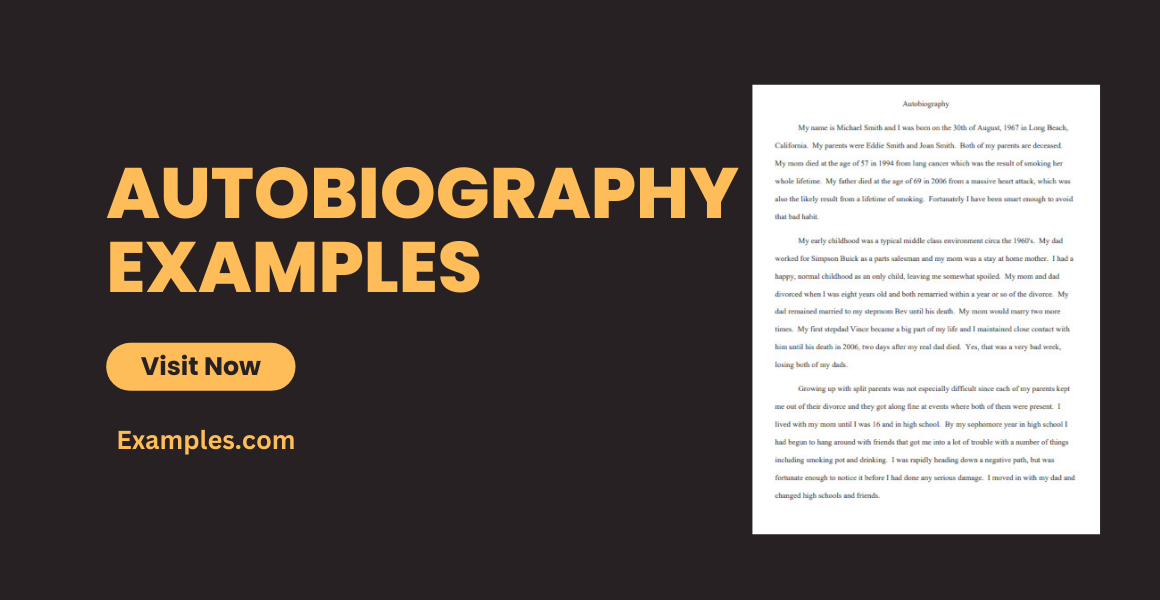
It is hard to slip into the shoes of a person and see the world as how they see it. One easy way to rectify this is by reading an autobiography about the life of a specific individual.
1. Western Autobiography
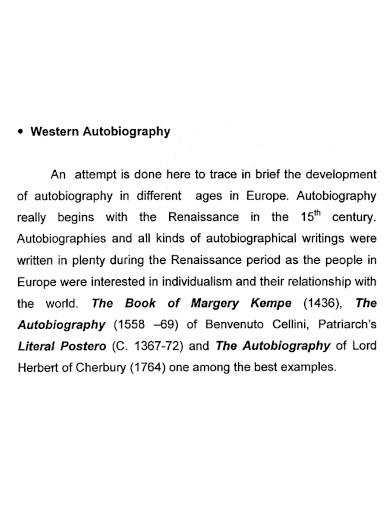
Size: 829 KB
2. Autobiography Sample
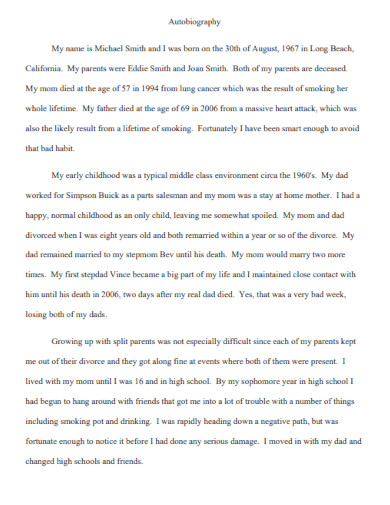
Size: 10 KB
3. Autobiography of a Giraffe

Size: 20 KB
4. Philosophy as Autobiography

Size: 142 KB
5. Autobiography PDF

Size: 556 KB
6. An Autobiography
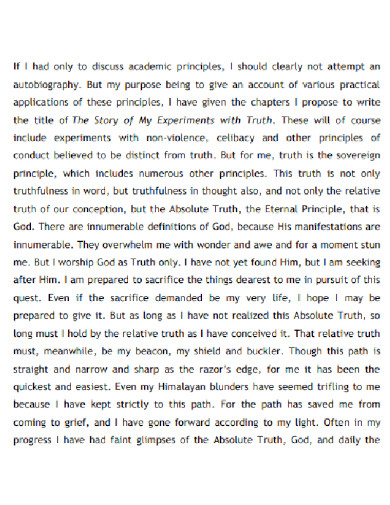
7. Own Autobiography
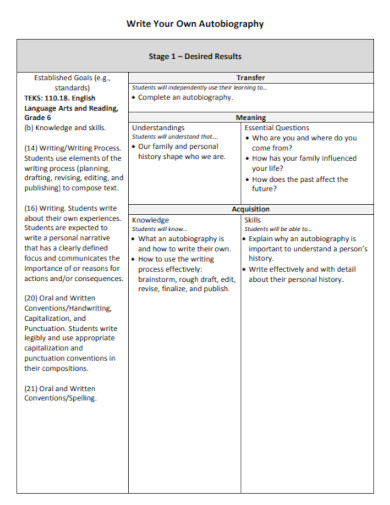
Size: 445 KB
8. Autobiography as a Literary Form
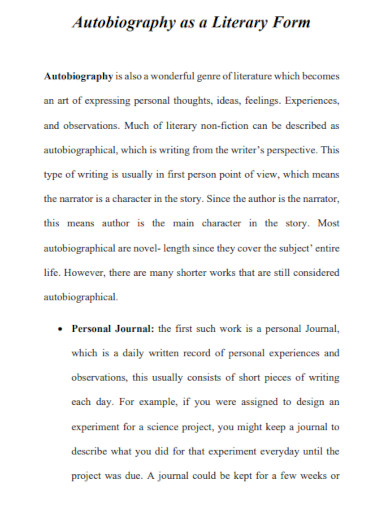
Size: 65 KB
9. Autobiography in Five Short Chapters
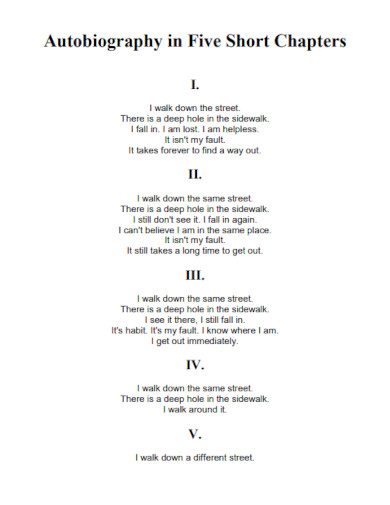
10. On the Genre of Autobiography
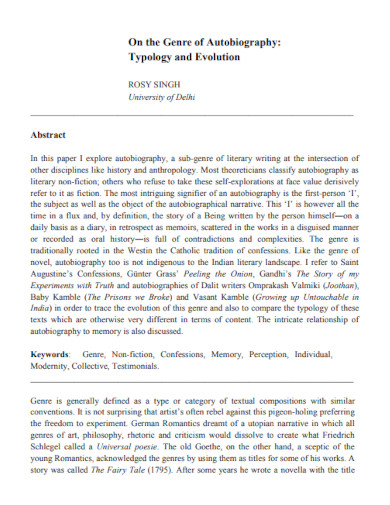
Size: 384 KB
11. Autobiography as a Literary Genre
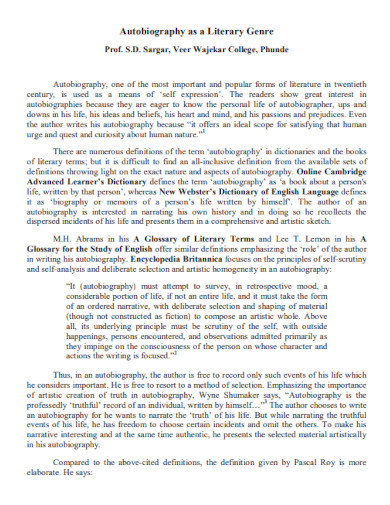
Size: 76 KB
12. Autobiography
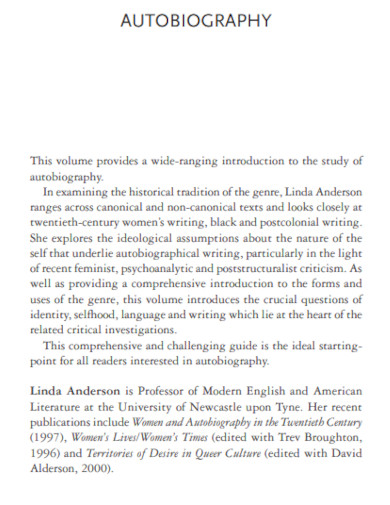
Size: 472 KB
13. The Autobiography Teresa of Avila
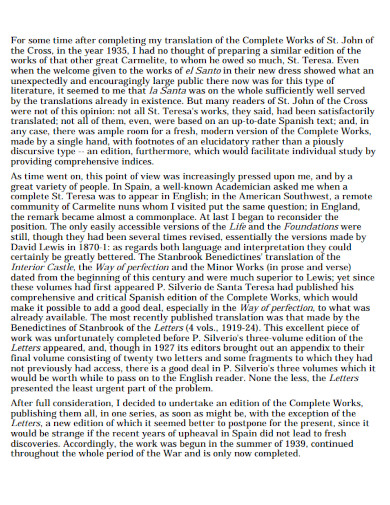
Size: 508 KB
14. Fiction and Autobiography
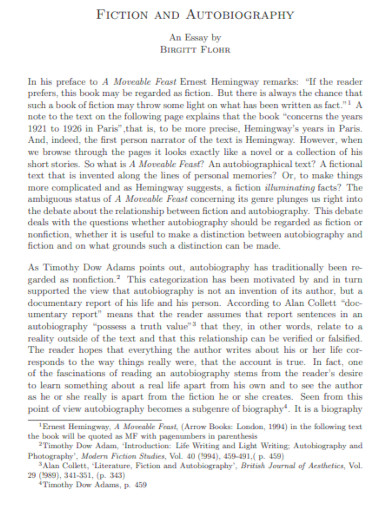
Size: 124 KB
15. Autobiography as Fiction
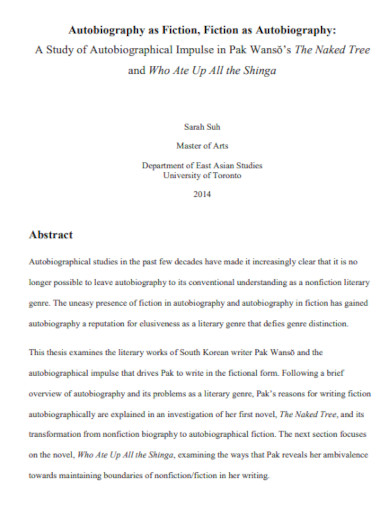
Size: 223 KB
16. Resistances to Autobiography
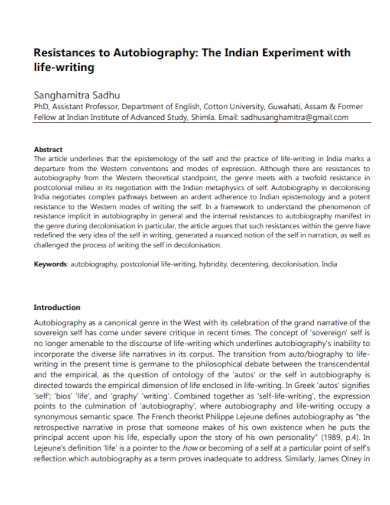
Size: 229 KB
17. Autobiography Format

Size: 579 KB
18. Autobiography and Biography
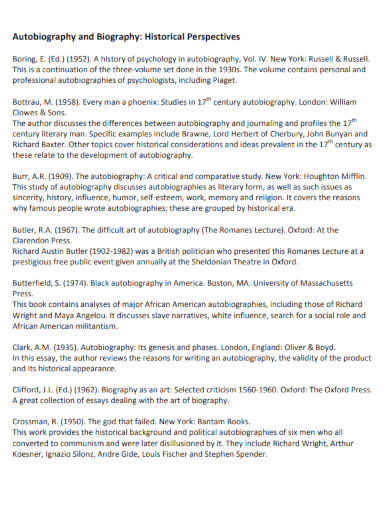
Size: 471 KB
19. Autobiography Literary Confession

Size: 270 KB
20. Autobiography Sample Template
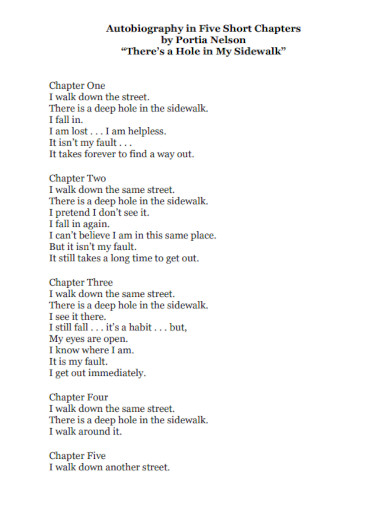
21. 5-Minute Autobiography
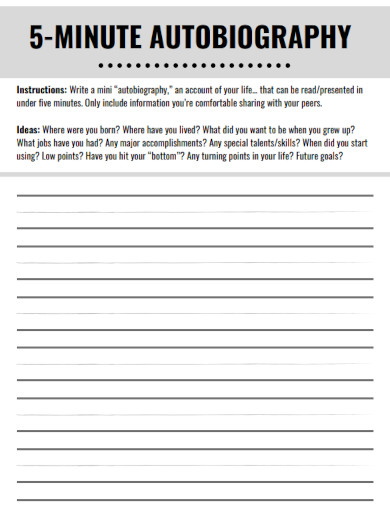
Size: 159 KB
22. The Indian Autobiography
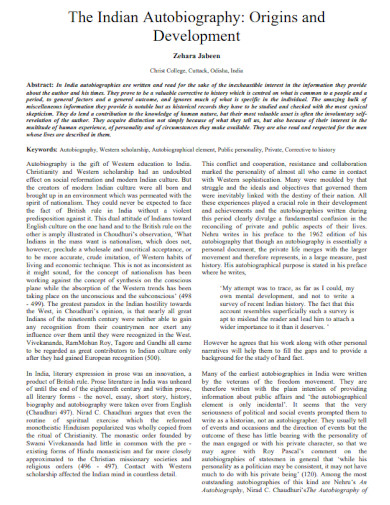
Size: 225 KB
23. Standard Autobiography
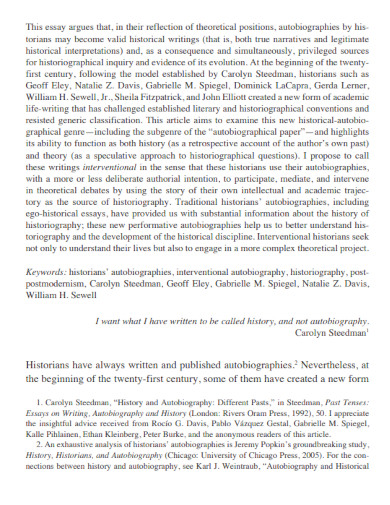
Size: 281 KB
24. The Autobiography of George Muller
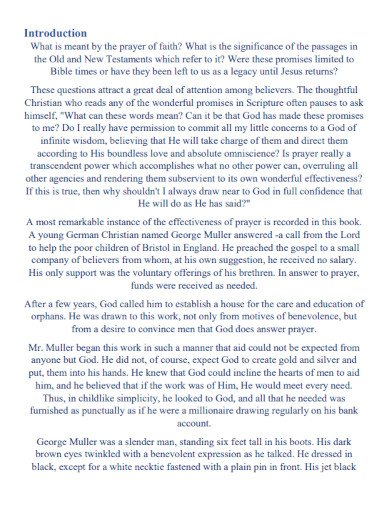
Size: 533 KB
25. Biography and Autobiography

Size: 849 KB
26. Basic Autobiography
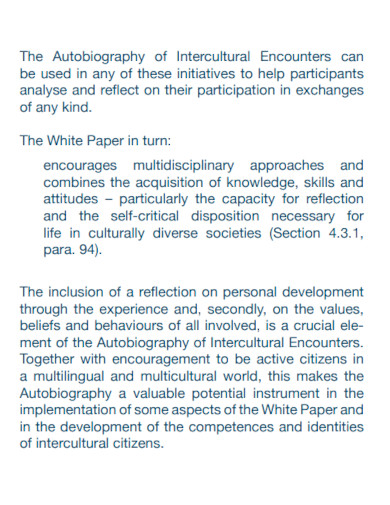
Size: 738 KB
27. Autobiography Manual
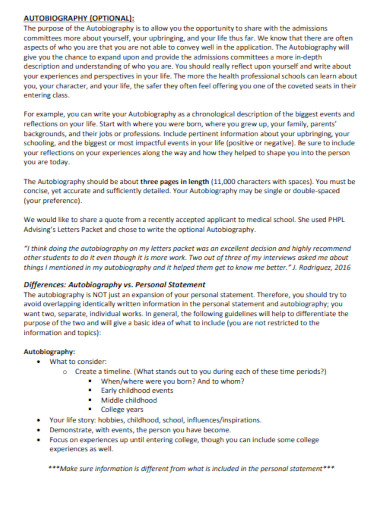
Size: 170 KB
28. Autobiography Do’s and Don’ts
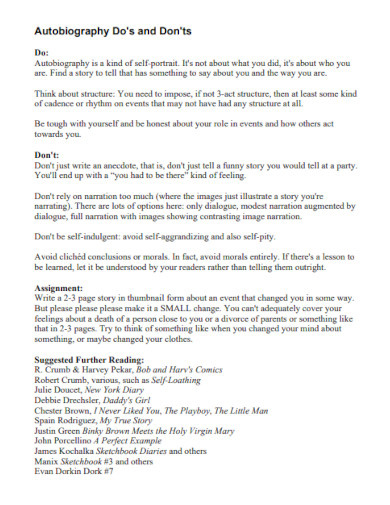
Size: 29 KB
29. Autobiography An Analysis
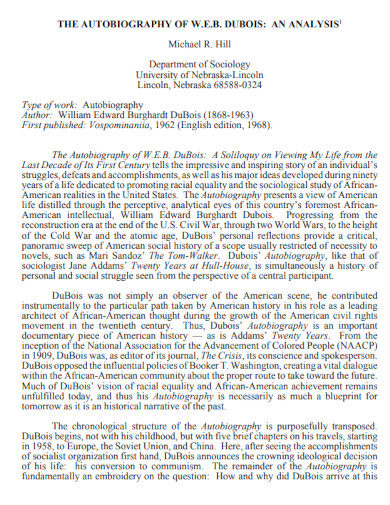
30. The Confessions as Autobiography
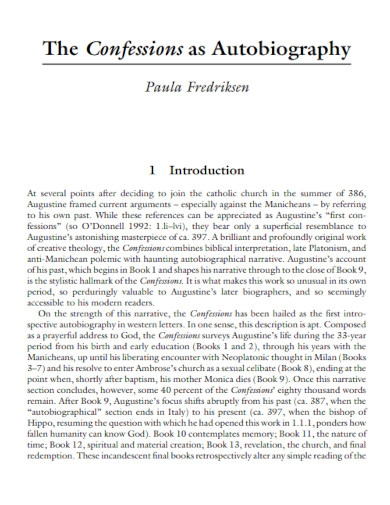
Size: 87 KB
31. Writing a Autobiography
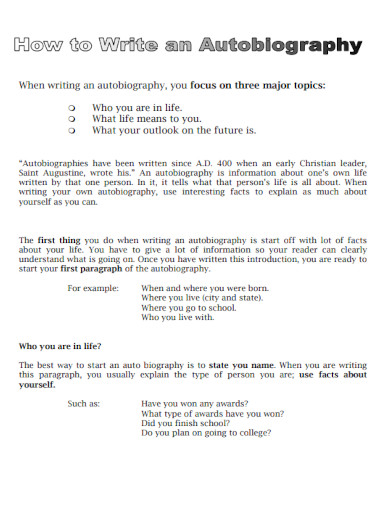
Size: 56 KB
32. Autobiography As Narrative
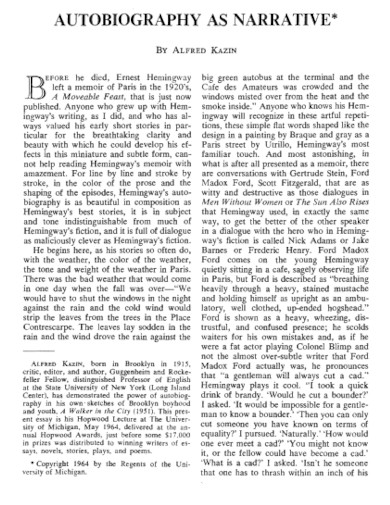
33. Autobiography of Benjamin Franklin
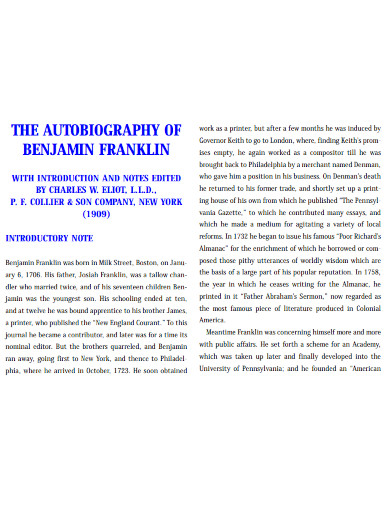
Size: 681 KB
34. Racial Autobiography
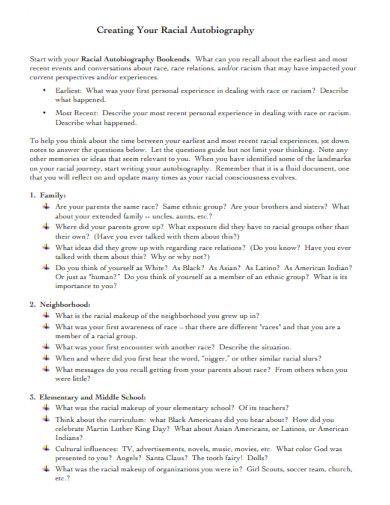
Size: 62 KB
35. Technology Autobiography
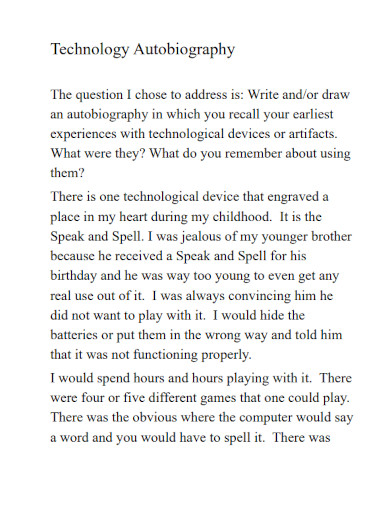
Size: 44 KB
36. Indian Autobiography Example
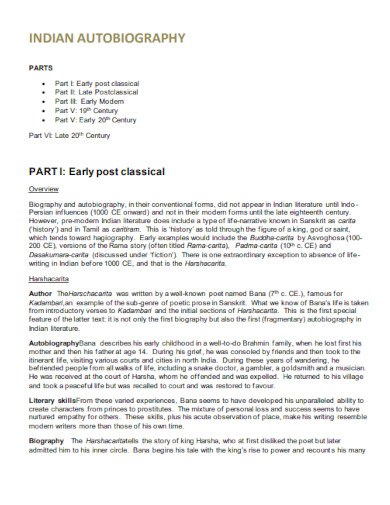
Size: 215 KB
37. Applicant Autobiography
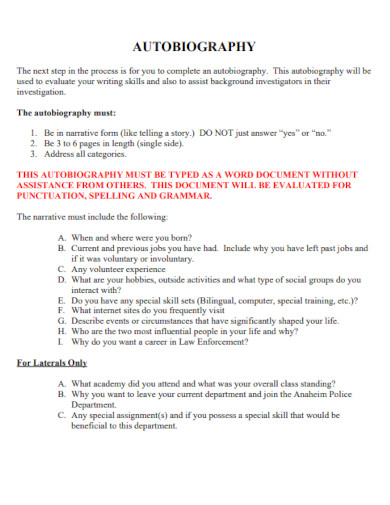
Size: 19 KB
38. Rationalism about Autobiography
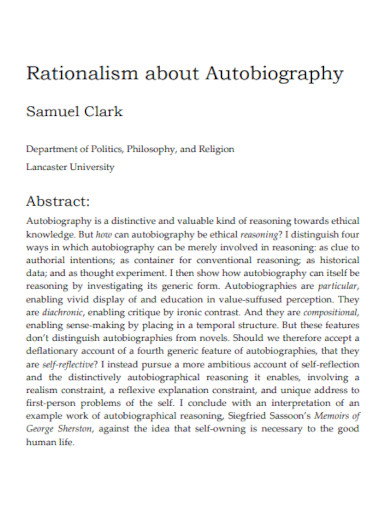
Size: 201 KB
39. Autobiography as Myth-Making
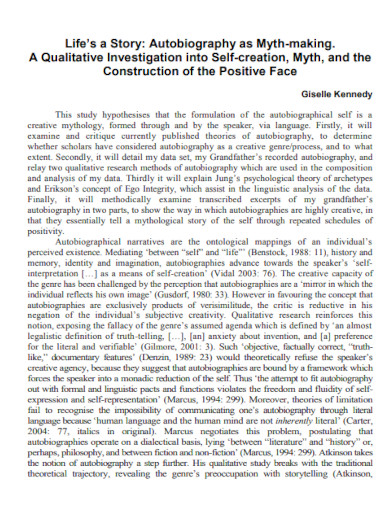
40. Autobiography Rubric
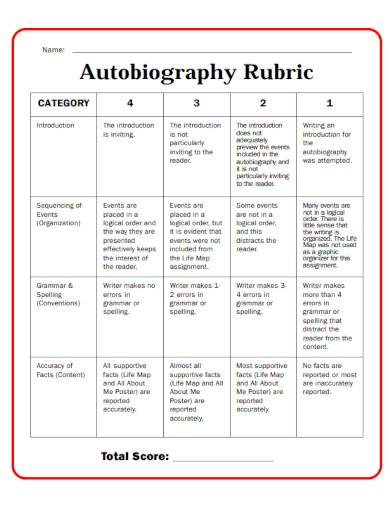
41. Autobiography Course of Study

Size: 111 KB
42. Early Transsexual Autobiographies
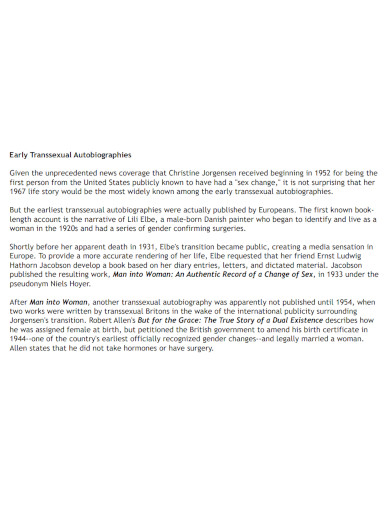
Size: 27 KB
43. A Scientific Autobiography
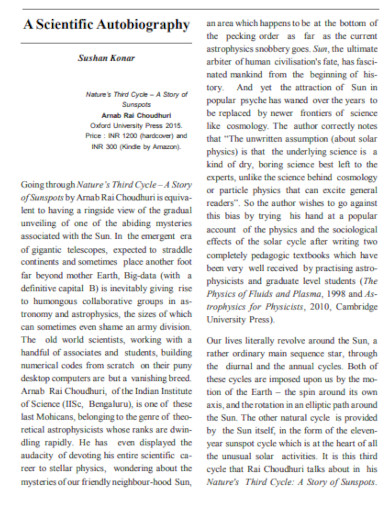
Size: 177 KB
44. Trends in Autobiography Theory
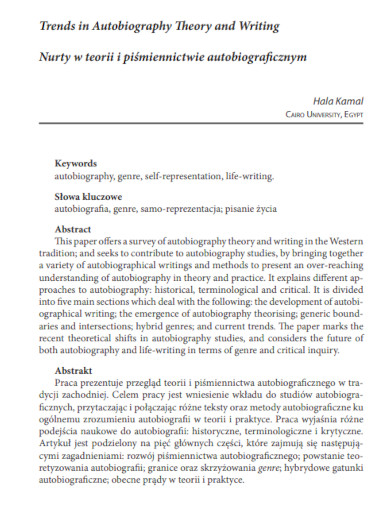
Size: 172 KB
45. Snapshot Autobiography
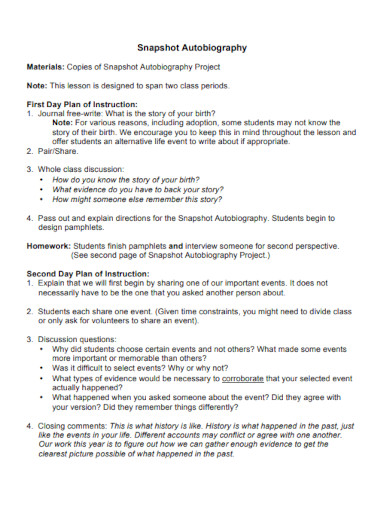
Size: 164 KB
46. Autobiography in English
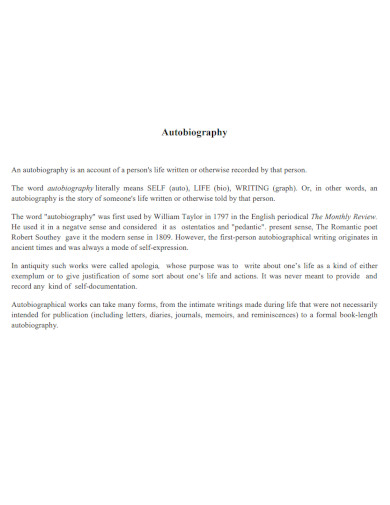
Size: 38 KB
47. The Use of Autobiography
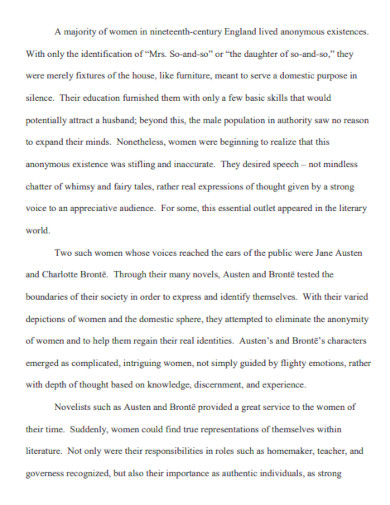
Size: 606 KB
48. Autobiography for Personal Development
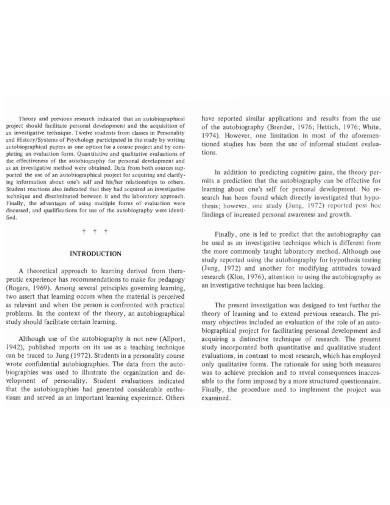
Size: 152 KB
49. Creative Autobiography
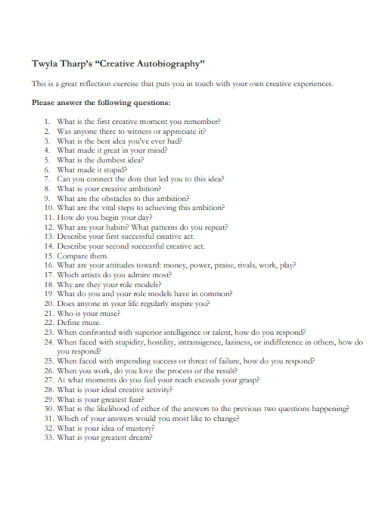
Size: 59 KB
50. Autobiography of a Reader
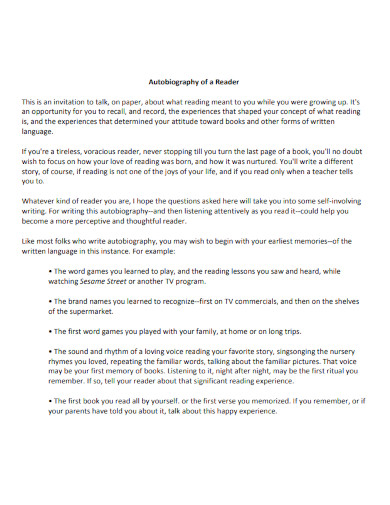
Size: 61 KB
51. Autobiography Writing Assignment
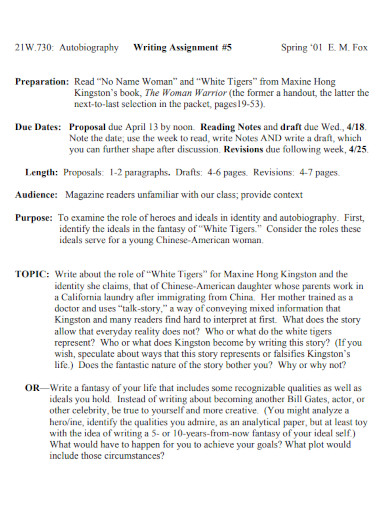
Size: 81 KB
52. Celebrity Autobiography
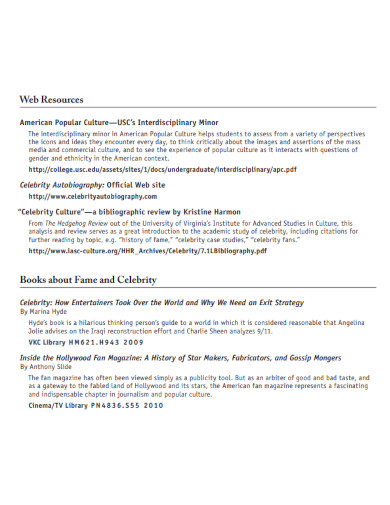
Size: 140 KB
53. Random Autobiography Poem
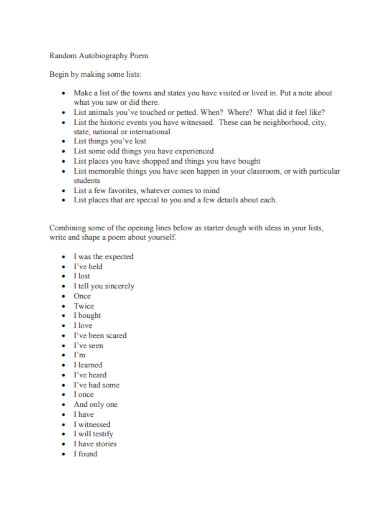
Size: 129 KB
54. Benjamin Franklin Autobiography Example
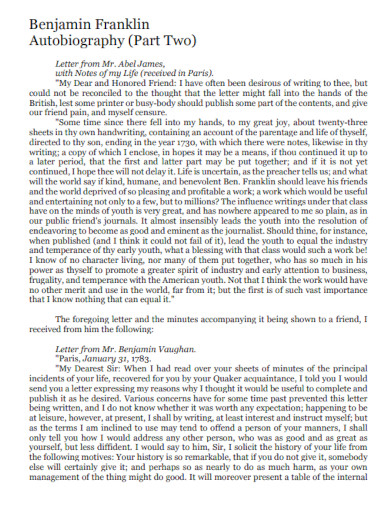
Size: 538 KB
55. Assata Autobiography
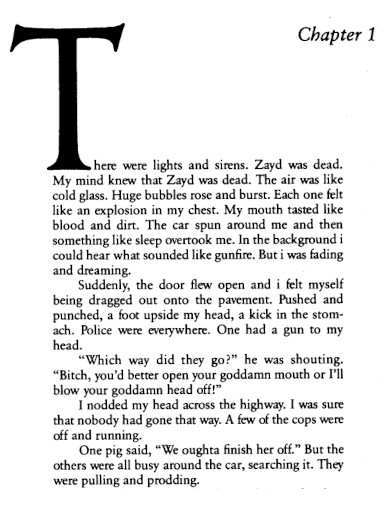
56. Autobiographical Numbers
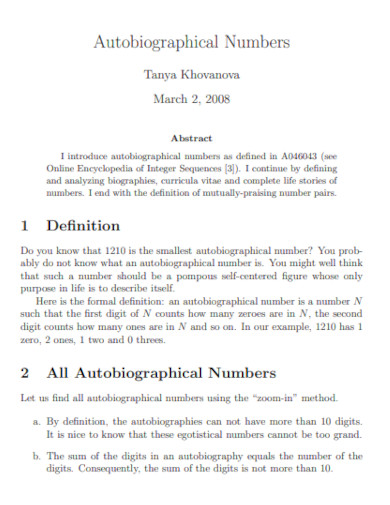
Size: 66 KB
57. Preparing Your Autobiography

Size: 17 KB
58. Literacy Autobiography
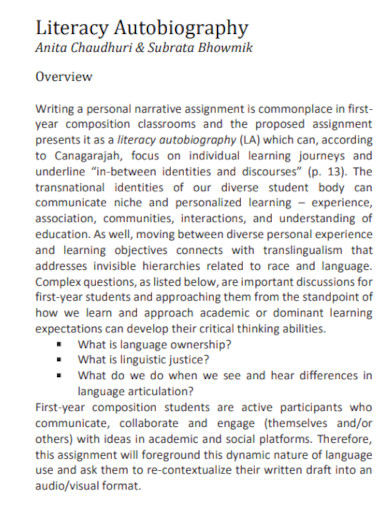
Size: 245 KB
59. Artist Autobiography
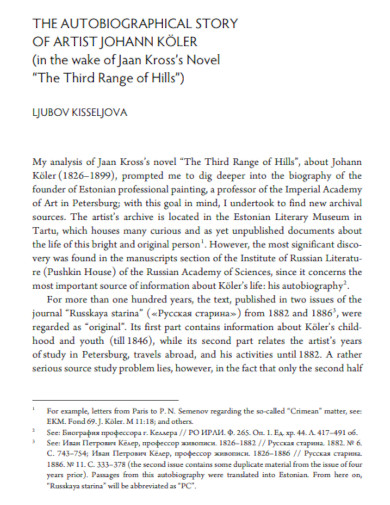
Size: 67 KB
60. Printable Autobiography
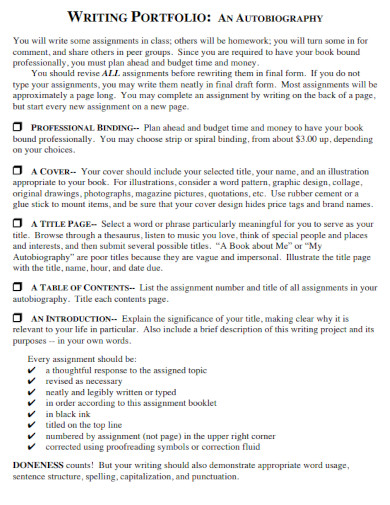
Size: 350 KB
61. Lincoln Autobiography
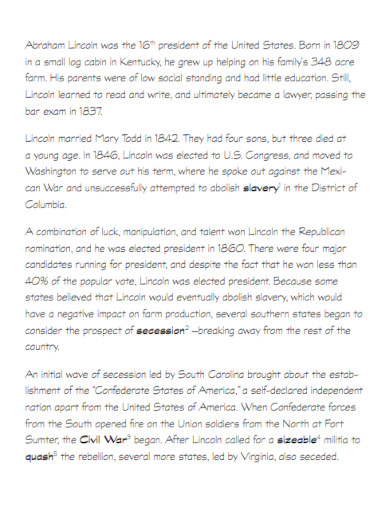
62. Monster Autobiography
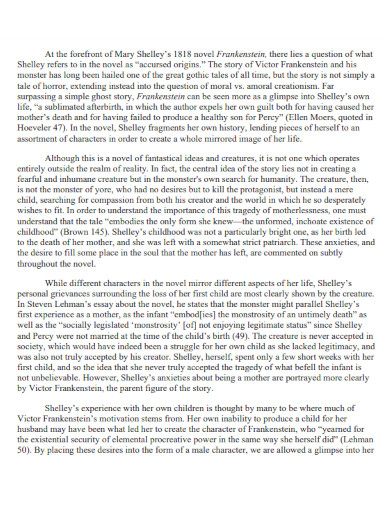
Size: 145 KB
63. Slave Autobiography
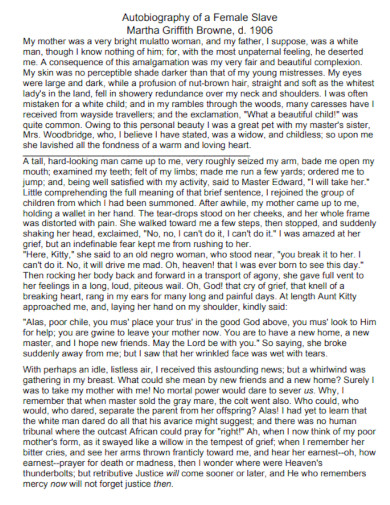
Size: 50 KB
64. The Autobiography of a Beatle
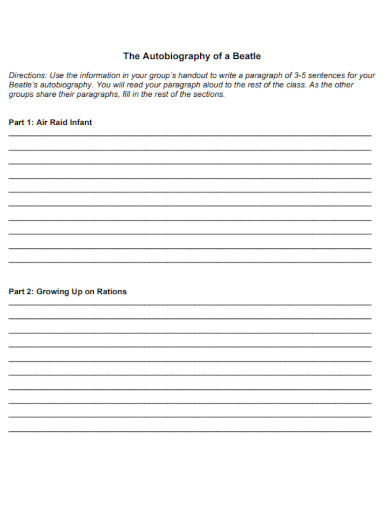
65. Linguistic Autobiography

Size: 248 KB
66. Autobiography in the Arabic Literary

67. Madonna Autobiography Writing
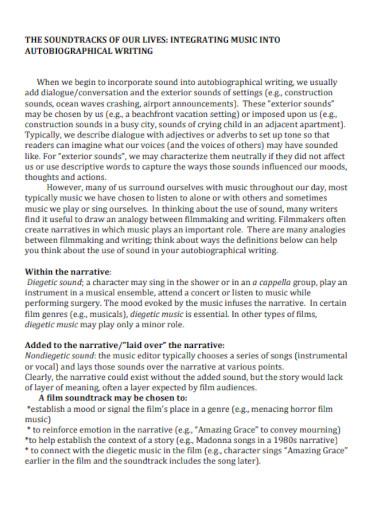
Size: 344 KB
68. Guided Autobiography
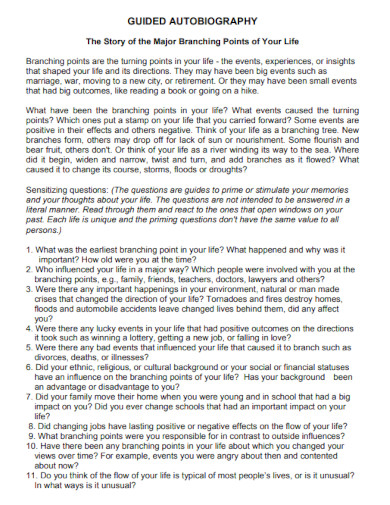
69. Autobiography & Postmodernism
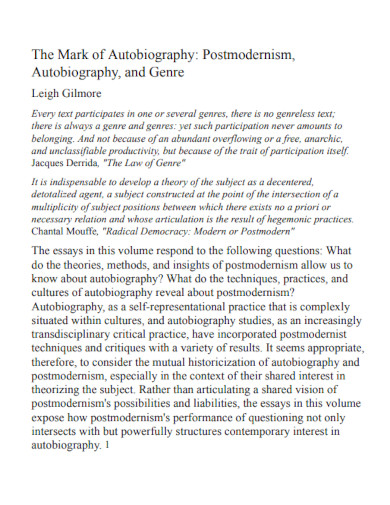
70. The Power of Autobiography
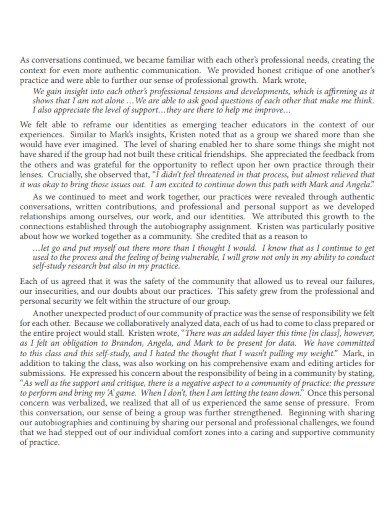
Size: 186 KB
71. Formal Autobiography Writing
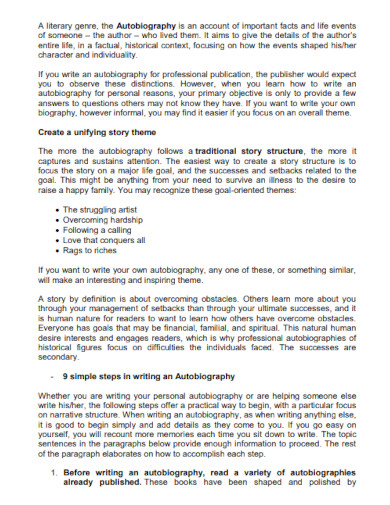
Size: 360 KB
72. Critical Autobiography as Research
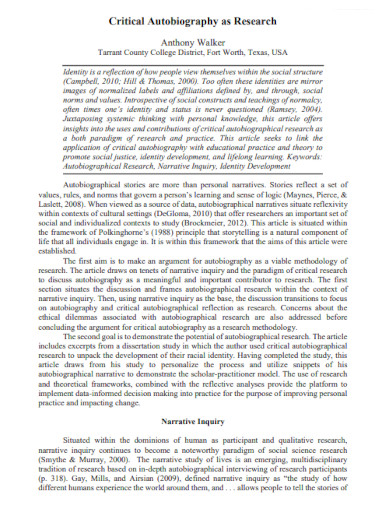
73. Autobiography as History
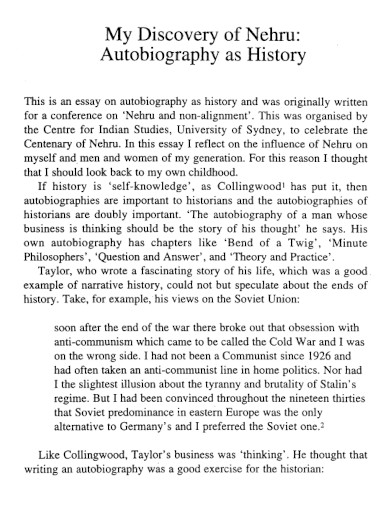
Size: 669 KB
74. Benefits of Autobiography
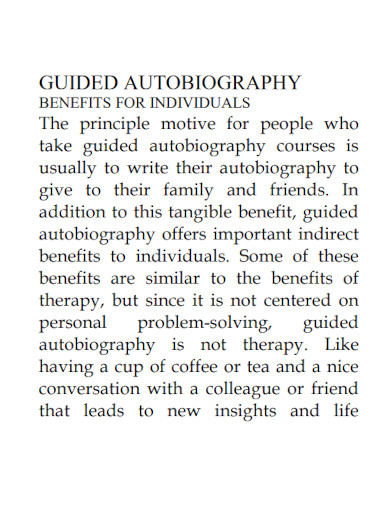
Size: 120 KB
75. Educational Autobiography

Size: 138 KB
76. Autobiography Handout
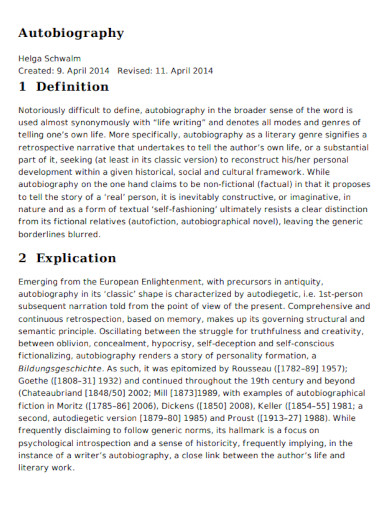
77. Sample Learning Autobiography
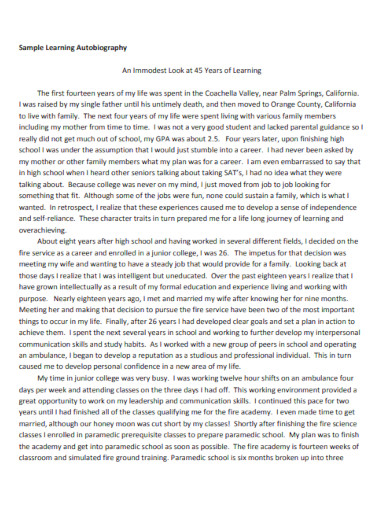
Size: 228 KB
78. Literature Review Autobiography
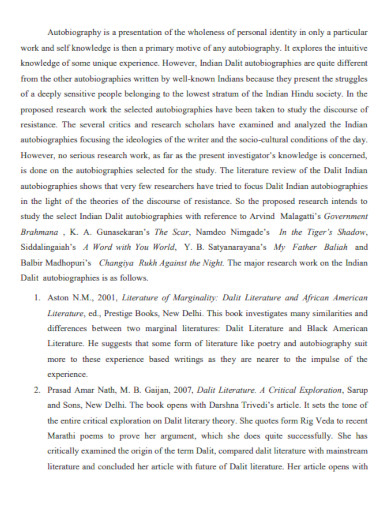
Size: 40 KB
79. Rambling Autobiography
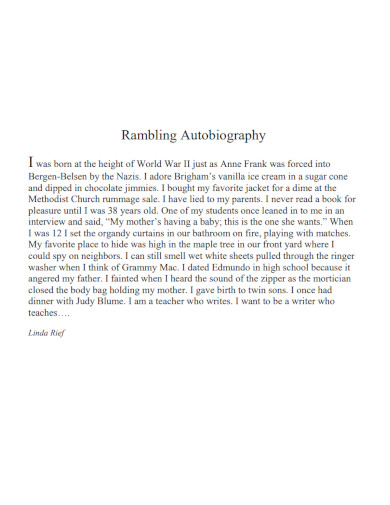
80. Autobiography Outline
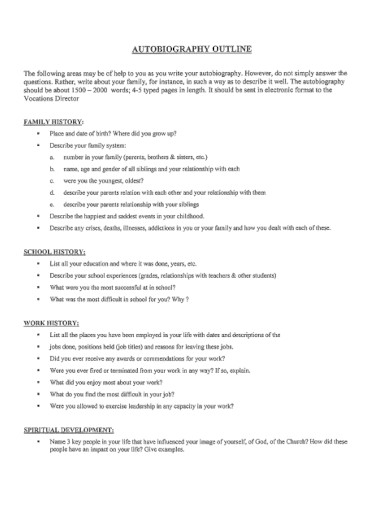
Size: 53 KB
81. Autobiography Structure

82. Assamese Autobiography
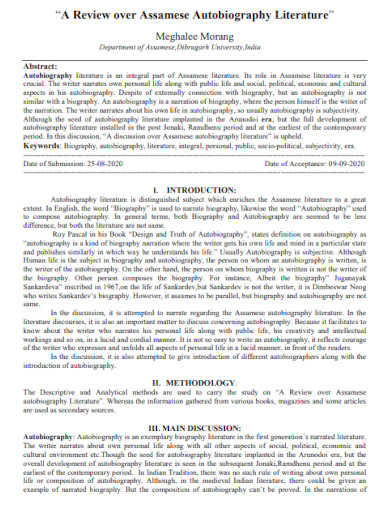
Size: 264 KB
83. Professional Autobiography
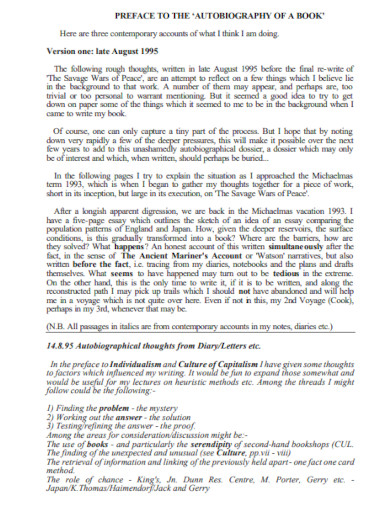
84. Short Autobiography

Size: 80 KB
85. Educational Autobiography Paper
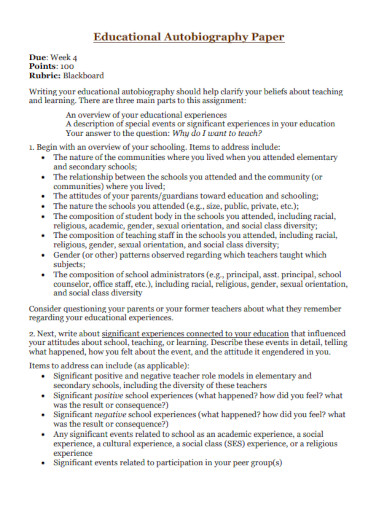
Size: 72 KB
86. Autobiography by School
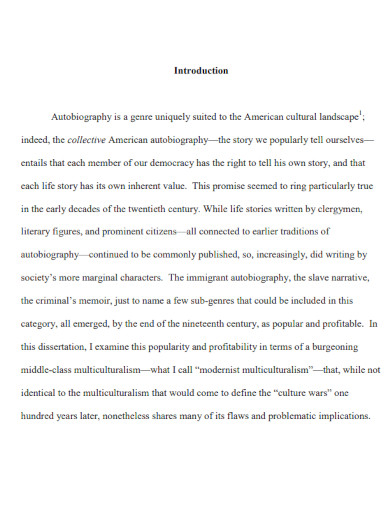
87. The Autobiography of an Ex-Colored Man
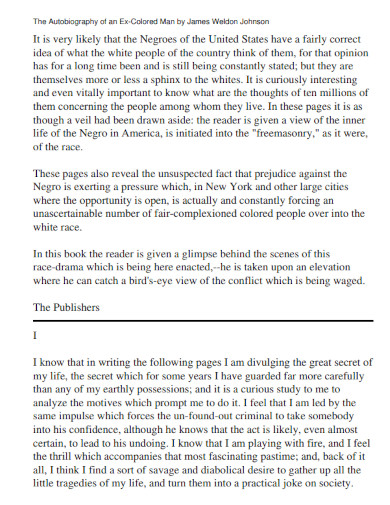
Size: 486 KB
88. Cultural Autobiography
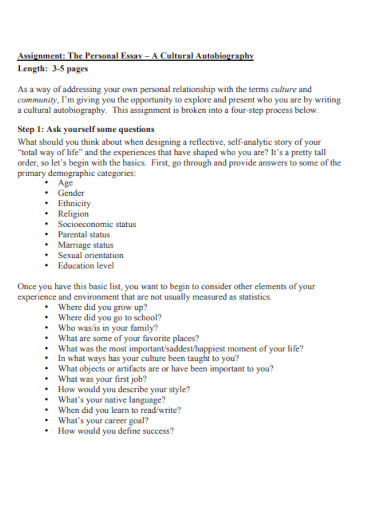
Size: 71 KB
89. Autobiography in Salman Rushdie
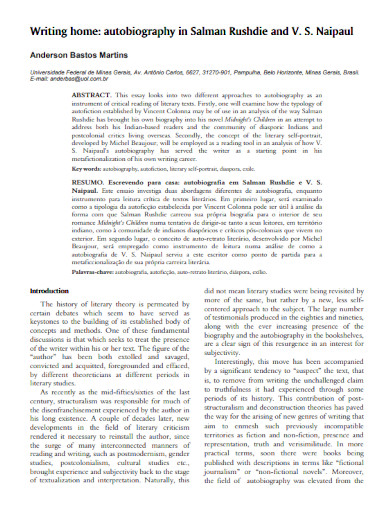
90. Melanie Klein’s Autobiography
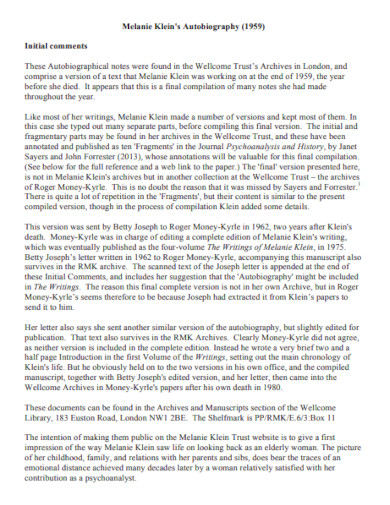
Size: 10 MB
91. Science Fiction Autobiography

92. Autobiographical Introduction
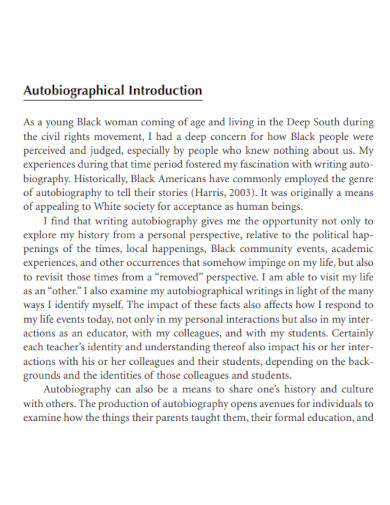
Size: 192 KB
93. My Autobiography Worksheet
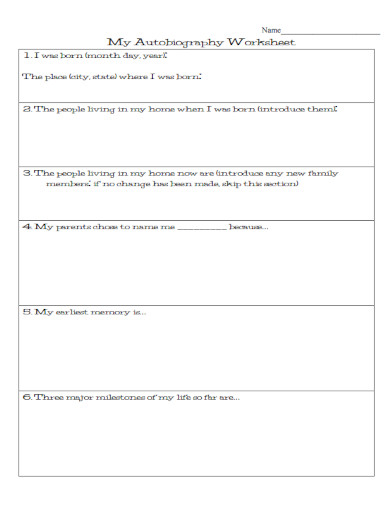
Size: 28 KB
94. Autobiographical Worksheet
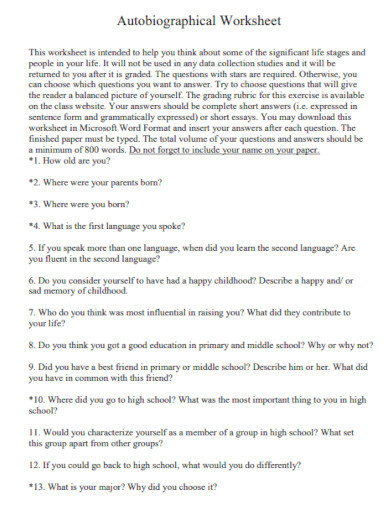
95. Autobiography Lesson Plan
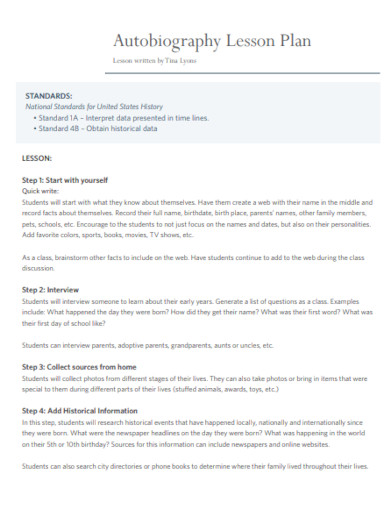
Size: 169 KB
96. Autobiography Bingo
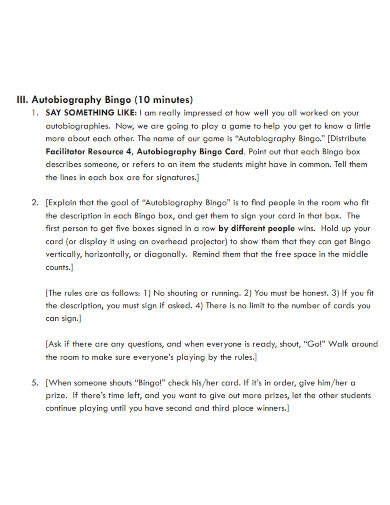
Size: 240 KB
97. Autobiography Sample Lesson Plan
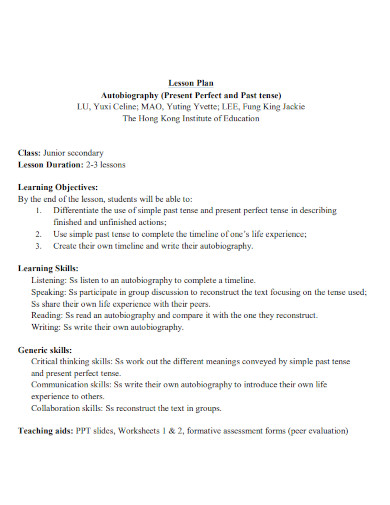
Size: 118 KB
98. Autobiography Prompts
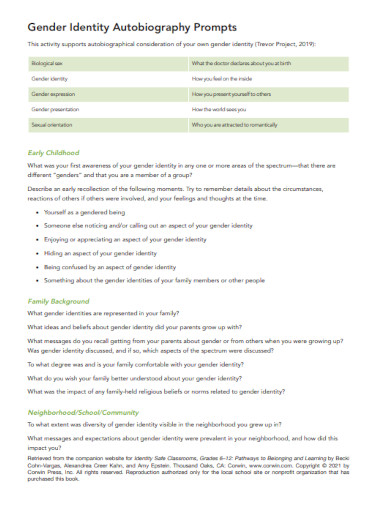
Size: 58 KB
99. My Leadership Autobiography

Size: 214 KB
100. Truth in Autobiography
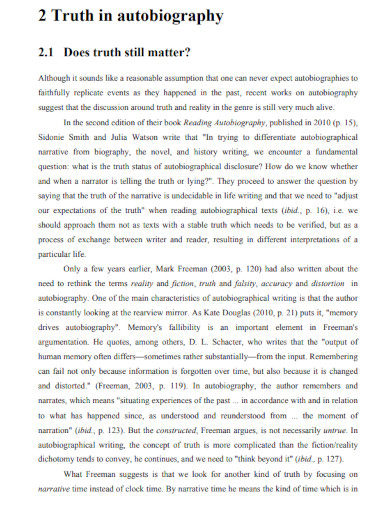
What Is an Autobiography
An autobiography is a type of non-fiction book that narratively explores the life of an individual. A sub-category of biographies, the autobiography is written by the subject of the autobiography, which incorporates the use of first-person perspective to allow the readers to easily slip into the shoes of the subject.
How to Start an Autobiography
A well-written autobiography will include accurate accounts that the author has gone through without sacrificing the author’s subjectivity. Examples of autobiographies include the Autobiography of Malcolm X and the Narrative of the Life of Frederick Douglass . If you are still confused and want to use other autobiography references, you may use any of the autobiography formats , examples , samples , and PDFs on the list above.
1.) Create a Timeline of Events
Begin by writing or noting down a timeline of events that you have been through. This will should include accurate dates, the title of the event, the people involved, and the description of the event. You will need to make sure the timeline is properly arranged as this will serve as the basis for the contents of the books.
2.) Make an Outline Based on the Timeline
After you have made a timeline of your life events, you will need to use the timeline to create the outline of the autobiography. The outline will help you easily write and arrange the contents of the autobiography.
3.) Start Writing the Autobiography
Using the outline, you will then start writing your autobiography, note it is possible for you to not wholly follow the outline you have made. This writing process will span from the span of months or even years.
4.) Edit the Autobiography
Once you have finished writing the contents of the autobiography, you will now need to proceed to the editing phase of the writing, This means you will have to let test readers read your autobiography to provide feedback, which is used to increase the quality of your autobiography.
Biography vs autobiography; what are the significant advantages and disadvantages between biographies and autobiographies?
Biographies are a type of book that narrates a specific individual’s life story written up by a different individual with or without the specific individual’s permission. While autobiographies are a type of book that also narrates a specific individual’s life story but it is written up by the same individual the book is about. This means biographies are significantly more objective in nature when compared to autobiographies, but the caveat is that autobiographies may be more accurate when compared to biographies. In conclusion, each of these types of non-fictional books has its small advantages and disadvantages that are wholly caused by who is writing the narrative.
Memoir vs autobiography; what are the differences between memoirs and autobiographies?
A memoir is a type of narrative that focuses on an individual’s life during a specific event for a group of years, this narrative is written by the same individual. While an autobiography is a type of narrative that focuses on the individual’s whole life story which is written up by the same individual. Memoirs are used to account for a person’s perspective and personal experience on a specific event. This is juxtaposed by the autobiography’s length which would span the author’s entire life starting with their birth. Note that an autobiography will always lack the more recent months or years, due to the fact the long production length of an autobiography.
Why are autobiographies vital, and what is their appeal?
Autobiographies allow us to understand and glean the person’s past and present perspectives and beliefs. This will also allow us to view the person’s life through their shoes and lenses, which could provide us with a detailed account of events, relationships, and stories that have shaped the subject’s perspective, beliefs, and personality. A good autobiography is introspective, and self-reflective, which is good for both the reader and the writer.
An autobiography is a type of book and a sub-category of biography that narrates an individual’s life story. The writer of the autobiography is the same individual who is the subject of the book. In conclusion, a well-written autobiography allows the reader to understand the perspective of the subject while allowing the writer to self-reflect and introspect their whole identity and life.

AI Generator
Text prompt
- Instructive
- Professional
10 Examples of Public speaking
20 Examples of Gas lighting
Please log in to save materials. Log in
- Resource Library
- Lesson Plan
- litflix-oct22
- litflix-season1
- utah-mac-lesson
Education Standards
Utah core english language arts (2011).
Learning Domain: Writing
Standard: Write narratives to develop real or imagined experiences or events using effective technique, descriptive details, and clear event sequences.
Standard: With some guidance and support from adults, use technology, including the Internet, to produce and publish writing as well as to interact and collaborate with others; demonstrate sufficient command of keyboarding skills to type a minimum of two pages in a single sitting.
Autobiography Rubric
5th grade autobiography unit.
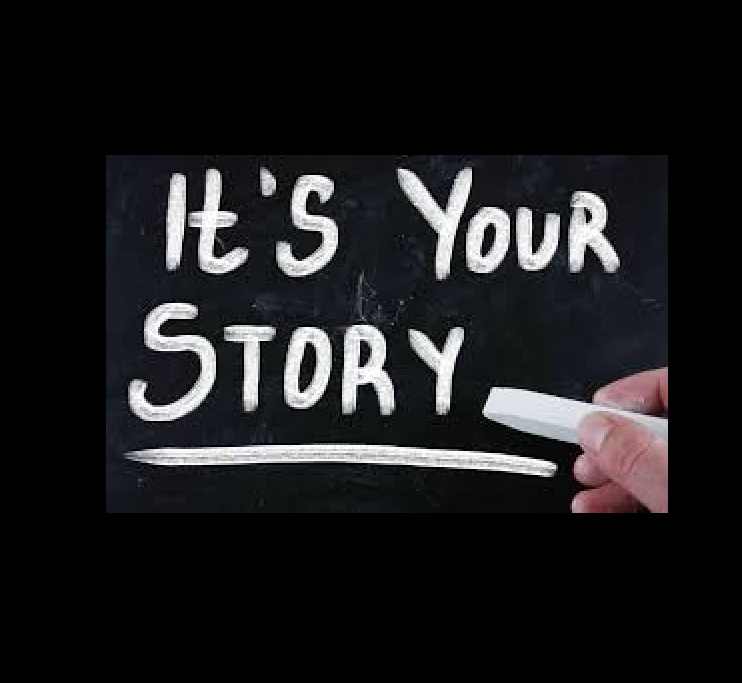
This is a lesson plan can be used to add technology to your classroom. Students will creae an Narrative autobiography in both a media form and a 5 paragraph essay.
Students will be writing an autobiography in an in person lesson that requires them to learn and understand steps of an autobiography, publish a written copy, and publish a form of technology to go along with their lesson that will be presented to the class. Students can use pages, iMovie, or Garageband to create their technology piece.
Background for Teachers
To teach this lesson you will need an understanding of the 5th grade writing process as well as what needs to be taught to teach autobiography writing. You will also need a basic understanding of how to use pages, iMovie, and Garageband.
Step 1 - Goals and Outcomes
Step 1: Goals and Outcomes
Students will be able to write a 5 paragraph autobiography and present their life story to the class using a form of media/technology.
Writing Standard 3
Write narratives to develop real or imagined experiences or events using effective technique, descriptive details, and clear event sequences.
Orient the reader by establishing a situation and introducing a narrator and/or characters; organize an event sequence that unfolds naturally.
Use narrative techniques, such as dialogue, description, and pacing, to develop experiences and events or show the responses of characters to situations.
Use a variety of transitional words, phrases, and clauses to manage the sequence of events.
Use concrete words and phrases and sensory details to convey experiences and events precisely.
Provide a conclusion that follows from the narrated experiences or event
Writing Standard 6
With some guidance and support from adults, use technology, including the Internet, to produce and publish writing as well as to interact and collaborate with others; demonstrate sufficient command of keyboarding skills to type a minimum of two pages in a single sitting.
Step 2 - Planning Instruction
Prior to beginning their autobiographies tell students that an autobiography tells the story of someone’s life written by that person. To get ideas flowing about their own life students can create an ABC list of things about themselves. Ex. A is for apples which is my favorite fruit. U is for Utah because that is where I live. Students could create this using words or pictures.
Step 3 - Instruction
Students will fill out a graphic organizer to plan their autobiographies. They should start with a brainstorm where they can reflect on who they are and what they want to include in their autobiography. Remind students they will be telling their life story in narrative form. When they tell the story it will flow in order from their first part of life, growing up, their family, to their next part of life like school, and friends, etc.
Things they can brainstorm:
Family Members
Favorite Family Memory
Hopes and Dreams for the Future
Interesting Facts about themselves
Schools attended and teachers
Current Hobbies and Talents
Favorite School Memories
Favorite things like; food, sport, school subject, candy, TV show, movie, book, restaurant, music, super hero. Etc…
Remind students a narrative should include:
Beginning: This is where you will introduce yourself. Remember you are to tell the story of your life, so go in chronological order. Tell events in the order they happened.
Middle: Each body paragraph will progress to different major events in your life. Start with your family, school and friends, and end with what makes you unique. Remember to keep this in a narrative story-like format, of your life.
End: This is the conclusion of your autobiography. Here you wrap up your thoughts and leave lasting impressions with your reader.
Their 5 paragraph graphic organizer should include:
Introduction: Introduce my name, age and where I was born. Include one or two interesting facts about myself.
First,
This paragraph will be about my family. Dad and Mom, brothers and sisters. Tell a story about a favorite family memory.
Next,
This is about school and friends.
Then,
What makes me unique? Interesting story about something that has happened to me,
In conclusion,
Where am I currently in life? What am I doing daily? Activities, jobs, sports…
*Once their graphic organizers are complete they will type a final copy.
Last:
Students can use ipads, computers, or class ipods to take pictures of the things they want to use in their digital presentation. They may also bring pictures from home that they may want to use. Baby pictures, family events, etc.
Students can then choose if they want to create a flyer in pages of their life, an imovie with pictures and descriptions of their life, or a podcast recorded reading of them telling their life story in Garageband.
Step 4 - Assessments
Attached is a Rubric for the students 5 paragraph autobiography as well as the Rubric for their media presentation. Part of their assessment will also be presenting to the class. This is attached to the media presentation rubric.
Media Presentation Rubric for Autobiography
Version History

IMAGES
VIDEO
COMMENTS
Order your sections (from medium to high interest) Order the ideas in each section (from medium to high interest) Write three questions to answer in each section. Choose a starter sentence. Complete a title template. Write each section of your by completing the starter sentence and answering all three questions.
The strict definition of autobiography is a first-person account of its author's entire life. A memoir does not document the memoirist's full life story but rather a selected era or a specific multi-era journey within that author's life. Memoirs tend to be much more focused than autobiographies. The main difference between memoir and ...
Famous Autobiography Examples. Autobiographical essays are usually about famous people or historical figures. Just as a renowned autobiography of Benjamin Franklin tells us about his life, his unfinished records, his accomplishments, etc. Below are some examples of famous autobiographies for your better understanding:
Write an eye-catching autobiography title for your book. Leave out the minutia. If it doesn't move your story along, drop it. Tone matters. A good rule of thumb is to write your story like you were talking to a friend. Your story doesn't have to be a monotone race to the finish line. Spice it up. Add some sparkle.
Microsoft Word - Autobiography.doc. Autobiography. My name is Michael Smith and I was born on the 30th of August, 1967 in Long Beach, California. My parents were Eddie Smith and Joan Smith. Both of my parents are deceased. My mom died at the age of 57 in 1994 from lung cancer which was the result of smoking her. whole lifetime.
Structure of an Autobiography: Usually written in chronological order. Uses time connectives such as before, then, after that, finally, etc. Uses the names of real people and events. Is specific about times, dates, places, etc. Includes personal memories and specific details and descriptions.
Famous Personality Autobiography. The autobiography of benjamin franklin is one example of a famous personality autobiography. Similarly, these famous autobiography examples will provide you with everything to get started with your famous personality autobiography. It elaborates the family, education, and career details of Wolfgang Ketterle.
Step 4: Write with Detail and Emotion. An important aspect of how to write an autobiography for college is appealing to emotion. As you delve into each body paragraph, share your story with vivid details. Use descriptive language to bring your experiences to life for the reader.
When writing an autobiography, focus on FOUR major things: (1) who you are in life (how would you describe your personality), (2) what life means to you, (3) what major life events or critical issues have had an impact on your life, and (4) what your outlook on the future is. The first thing you do when writing an autobiography is start off ...
7 steps to write your own life story: Brainstorm your autobiography's focus and scope. Skim autobiographies for inspiration. Choose between autobiography and memoir. Outline key and illustrative life events. Draft key scenes from your life. Find strong transitions. Check details and get beta readers. 1.
1. The Diary of a Young Girl by Anne Frank. One of the best-known autobiographies, The Diary of a Young Girl, is an excellent example of a journal-style layout. Featuring the story of a young girl who is hiding during the Holocaust, aspiring writers will find inspiration in Frank's raw emotions and candor.
Fortunately, there are plenty of innovative and well-thought-out autobiography samples that are available. They can assist you in organizing your thoughts to come up with a great autobiography. These samples can save you valuable time, especially on how to start an autobiography. Check out our extra 40 biography templates.
Using your previous knowledge from your solo talk, or the fact sheets, choose the most important events in their life to write about. You can talk about their childhood if you wish. First Level - Choose 3-4 key events. Second Level - Choose 5-6 key events. Write down your chosen key events on your planning sheet.
Quick Tips for Writing a Successful Biography Writing your biography may not be an easy undertaking but it can be fun. While you want to be professional, you have more latitude to show your personality and creativity in how you tell your career story. Some additional tips to keep in mind: • Write your bio in the third person.
A personal biography template is a structured outline designed to guide individuals in documenting their life stories, achievements, and experiences. It provides a framework to organize personal details in a coherent and engaging manner. This template, created in our prior response, can assist users by simplifying the process of writing their ...
A biography is the story of someone's life as written by another writer. Most biographies of popular figures are written years, or even decades, after their deaths. Authors write biographies of popular figures due to either a lack of information on the subject or personal interest. A biography aims to share a person's story or highlight a ...
Length: 3-5 pages. As a way of addressing your own personal relationship with the terms culture and community, I'm giving you the opportunity to explore and present who you are by writing a cultural autobiography. This assignment is broken into a four-step process below. Step 1: Ask yourself some questions.
AUTOBIOGRAPHY. Please read this carefully before starting. You will need to allow more than one sitting to complete this. Remember that the purpose of this is to examine all of the effects of your substance use WITHOUT denial. Use your notebook to complete this assignment thoroughly. 1.
Be specific, talk about your growth, the experiences you've gone through until you get to what you are today. Much of what you are today was formed in your childhood. Do not forget to say that in your autobiography. 5. Expose your culture. The way you live, behave, what you like and even what you do not like.
Autobiography Example | PDF Sample. Wolfgang Ketterle - Autobiography (for "Les Prix Nobel") was born on October 21, 1957, in Heidelberg, a small town in Germany with a charming old city and a famous castle. My parents had come to Heidelberg after the second world war, when many people relocated within Germany searching for better ...
5-Year Strategic Plan. 50/50 Partnership Agreement. 504 Plan. 6 Word Memoir. 60 Day Workout Plan. 7th Edition APA Format. Autobiographies are a narrative of an individual who's life story is written by the same individual. Learn all about autobiographies and how to write one by reading this article all about them.
Sample Learning Autobiography An Immodest Look at 45 Years of Learning The first fourteen years of my life was spent in the Coachella Valley, near Palm Springs, California. I was raised by my single father until his untimely death, and then moved to Orange County, California to live with family.
Step 1 - Goals and Outcomes. Step 1: Goals and Outcomes. Students will be able to write a 5 paragraph autobiography and present their life story to the class using a form of media/technology. Writing Standard 3. Write narratives to develop real or imagined experiences or events using effective technique, descriptive details, and clear event ...